


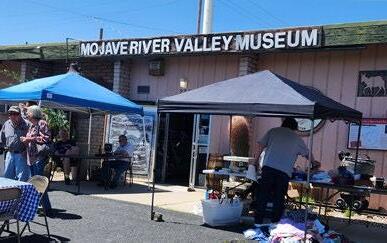
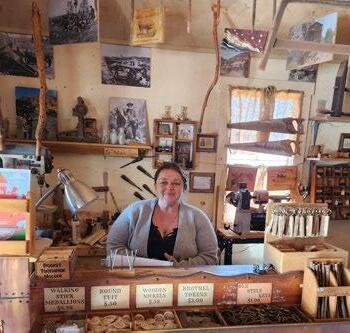

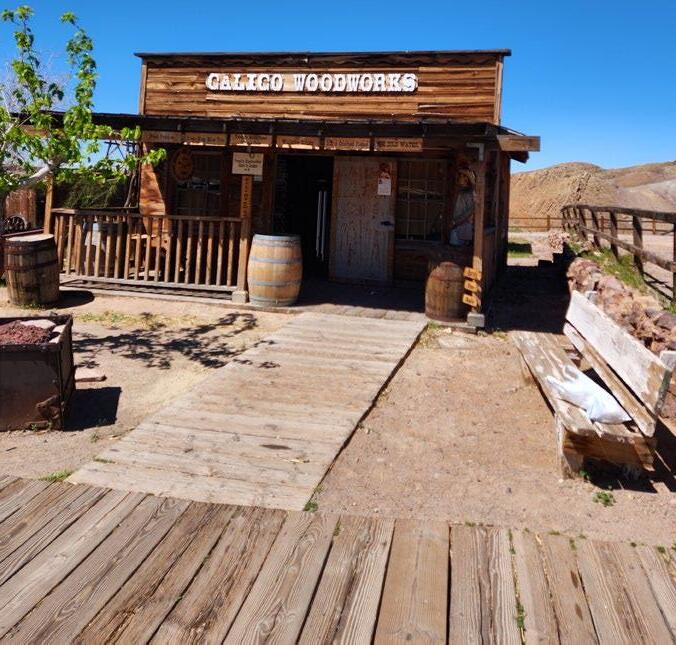
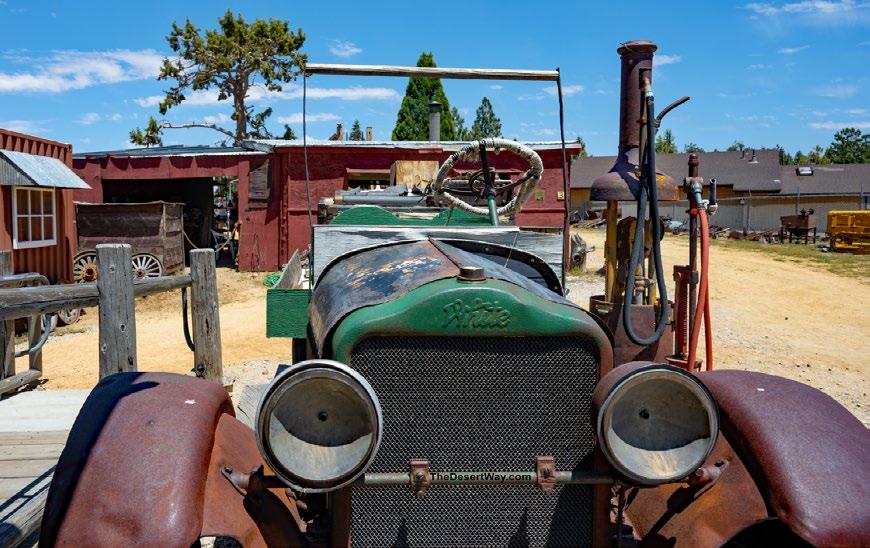

May 2024 - Issue #27 PRSRT STD U.S. POSTAGE PAID Victorville, CA PERMIT #187 PULSE PUBLICATIONS P O Box 290066, Phelan, CA 92329-0066 *************ECRWSSEDDM***** POSTAL CUSTOMER Check out the events going on in our area this month. SENIORS, VETERANS, FAMILIES, COMMUNITIES Stories inside PULSE PUBLICATIONS Use the QR-Code to find us online. Big Bear Valley Historical Museum: A Tale of Two Cities Gem Hunting in CALICO




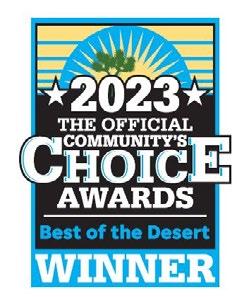


2 PULSE PUBLICATIONS May 2024 Joint Replacement Hand & Wrist Fracture Care Sports Medicine Spine Surgery ENJOY LIFE 760.358.0936 Services Include: 12490 Business Center Drive Suite #100 Victorville sportsmedorthoinstitute.com 1890 W. Main Street Suite #130 Barstow Six locations to serve you!
DID YOU TOO NOTICE how quick the weather here in the High Desert changed? Seems overnight we went from cold to HOT, well not as hot as it will get in July/August. We have a saying in our area that we know when it’s winter, the wind is cold and summer, the wind is hot. I do prefer somewhere in the middle.
We, along with our advertising partners, have been active within our communities. These activities includes Home Shows-Health Fairs-Grand Openings-Chamber functions & networking events. Our major advertisers each hold their own events that we encourage you to check out. The more you know about, and take care of, your health-finances-life styles and local culture/history are within your reach by reading the PULSE.
We are truly honored to be able to bring you each month exciting new articles and information that add value to your daily life.
The TEAM here at PULSE Publications thank you for your support. Using and/or letting our advertisers know you enjoy the PULSE insures our continuing to publish the newspaper.
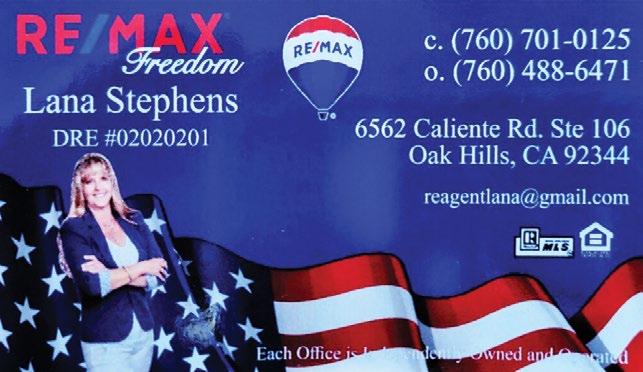
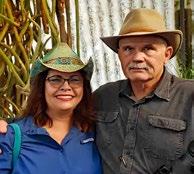
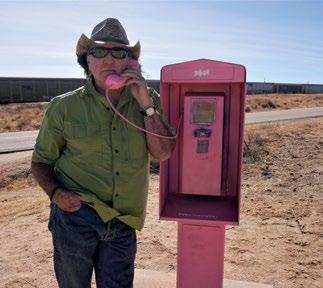
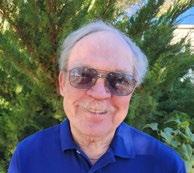
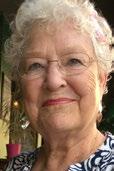

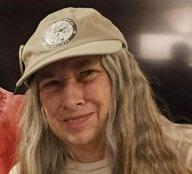



3 PULSE PUBLICATIONS May 2024 Editorial P O Box 290066 - Phelan, CA 92329-0066 10405 Mountain Road - Piñon Hills, CA 92372 PULSE PUBLICATIONS TIFFANIE WILLIAMS 1 442 364 4884 Tiffanie@pulseofthehighdesert.info DEBBIE WALKER 1 760 900 9429 DWalker@pulsecustompublications.com JAMES CONKLE Publisher 1 760 617 3991 jim@motherroadenterprises.com 66jimconkle@gmail.com LORI WESTON 1 760 680 9472 Lori@motherroadenterprises.com Jim Conkle Our Writers John R. Beyer Collectors Edition John Beyer John Beyer has been published in numerous magazines, newspapers and the like for decades, writing on a variety of topics. John Wease John Wease is a published author, with his modern-day western fiction novel “The Horseman” available at the usual online sources. Ann Miner Parkinson’s Advocate eannminer@yahoo.com 760-954-2859 Jaylyn and John Earl Happy Wanderers Exploring the Mystery and Majesty of the Southwest Deserts thedesertway.com Marcy Taylor 1 760 985 1918 mltaylor@gmx.com JORGE LEANDRO RODRIGUES Graphic Designer 55 16 99991 0229 leandro.works@gmail.com John Paul Garner John is a retired high school football coach and veteran. He has published two books, lives in Barstow, and loves being a member of the HIgh Desert branch of the California Writers Club. Liz McGiffin 1 760.887.3427 Published author in local magazines, newspapers and book/Borrow SmartRetire Rich. Representing Senior Kicks Club Inside • News 4 Veterans - Page 8 • A Chat About Parkinson´s - Page 9 • Marcy’s Musings - Page 22 • Don’t miss up... events are fillin’ up!Page 27
Understanding the Importance of Mental Health Awareness Month
by Dr. Melissa Mischka, PsyD
EVERY MAY, a crucial spotlight shines on an often-overlooked aspect of our well-being: mental health. Mental Health Awareness Month is a time dedicated to raising awareness about mental health conditions, reducing stigma, and advocating for support and resources. This annual observance plays a pivotal role in encouraging conversations around mental health, promoting understanding, and emphasizing the importance of mental wellness for all.
Did you know that Mental Health Awareness Month was first established in the United States in 1949 by Mental Health America (MHA), a leading communitybased nonprofit organization.? I had no idea that this month has been around for over 70 years as it seems like people have only begun talking about it in recent years. Since its inception, it has grown into a global initiative observed by numerous countries and organizations. The month of May was chosen as a time to amplify mental health awareness due to its proximity to other key events like Mother’s Day and Memorial Day, providing abundant opportunities to reach diverse audiences.
The primary goal of Mental Health Awareness Month is to destigmatize mental health conditions and encourage individuals to seek help when needed.

Many people still hesitate to discuss mental health due to fear of judgment or misunderstanding. This observance seeks to change this narrative by fostering open discussions and emphasizing that mental health is just as important as physical health.
One of the most persistent barriers to mental health support is stigma. Stigma can lead to discrimination, social exclusion, and a reluctance to seek help. Mental Health Awareness Month aims to challenge these stigmas by providing accurate information, sharing personal stories of recovery, and showcasing the prevalence of mental health conditions across all demographics.
Through education and community outreach, Mental Health Awareness Month empowers individuals to recognize the signs of mental distress, support those in need, and cultivate empathy and understanding. By confronting misconceptions head-on, this observance
helps to create a more compassionate and supportive society.
Beyond awareness, Mental Health Awareness Month advocates for improved access to mental health services and resources. It highlights the importance of early intervention and effective treatment options. Many organizations use this month to promote mental health screenings, workshops, and initiatives that provide practical tools for managing mental health challenges.
Support networks play a crucial role during Mental Health Awareness Month and beyond. Communities, schools, workplaces, and healthcare providers come together to offer resources, counseling services, and educational materials. This collective effort demonstrates that mental health concerns affect us all and that support is available for those who need it.
As we navigate the complexities of modern life, Mental Health Awareness Month reminds us of the importance of caring for our minds as well as our bodies. Together, we can build a world where mental health is destigmatized, and everyone has the opportunity to thrive.


4 PULSE PUBLICATIONS May 2024

5 PULSE PUBLICATIONS May 2024
New York City in the High Desert
GOSH DARN IT, AMY ROSS KNOWS WHAT THE HECK
SHE’S DOING! As a Director of stage productions at Barstow Community College, she is extraordinary. To have orchestrated all the elements of a classical musical like “The Sound of Music” into a 3-hour festival of sight, sound, and storytelling was nothing short of magical. I was in awe when I saw “A Christmas Carol,” but the final showing of Rodgers and Hammerstein’s “The Sound of Music” left me wanting more.
Bravo Ms. Ross! Bravo cast and crew! What a splendid and, quite frankly, astonishing performance by all involved.
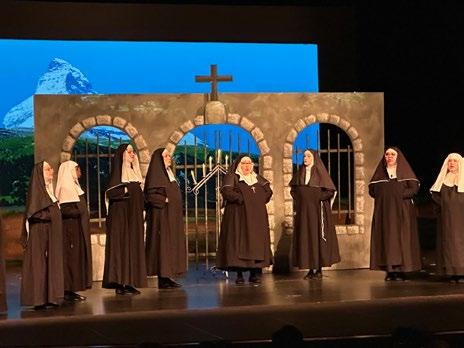
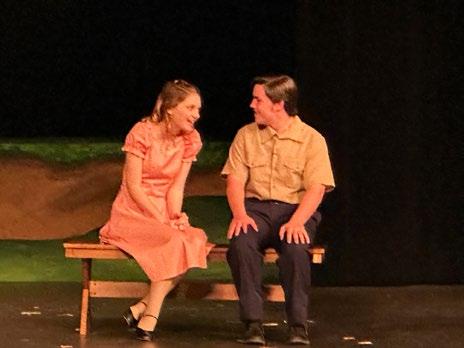
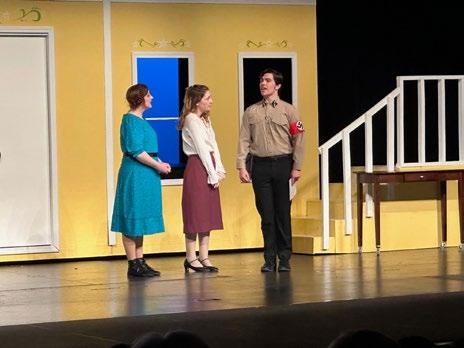
Everyone—from the sound crew to the set and costume designers, to the people working the lights, and most of all the actors themselves—were professional and perfect for their roles.
Red Lamb as Maria, the governess, and Kristine Nelson as Mother Abbess, whose singing of “Climb Every Mountain” before the Intermission enthralled the audience and left us breathless, were captivating as were the children and Steve Millikin as Captain Von Trapp. To name only them is a disservice to the amazing performances rendered by the entire cast. I’d list them all but haven’t the space but kudos to them as well. Perfection could not have been

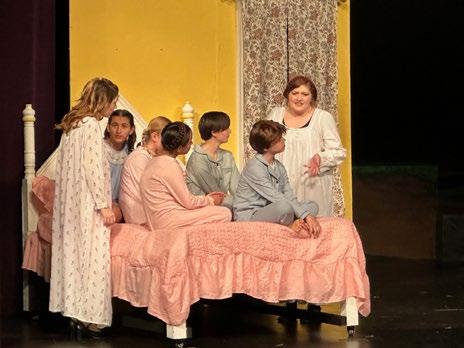
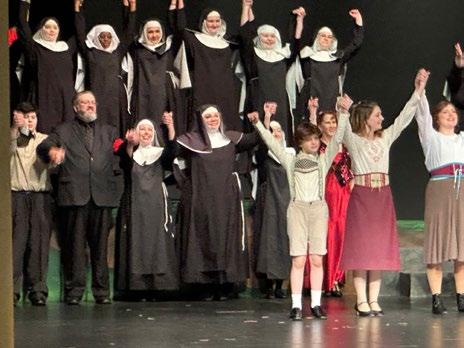
achieved without them.
By J.P.Garner
Again I was astonished by the OffBroadway and big city feel the show had. It was New York City in the High Desert. A phantasmagorical sampling of how theater can not only enhance our lives but elevate us. And, maybe, just makes us feel good. It did that and more. Barstow might be the town that is often ridiculed, but on the second Sunday in April, because of a cast and crew dedicated to their craft, and for however long the play lasted, we were made to feel special.
Saying thank you doesn’t seem enough.
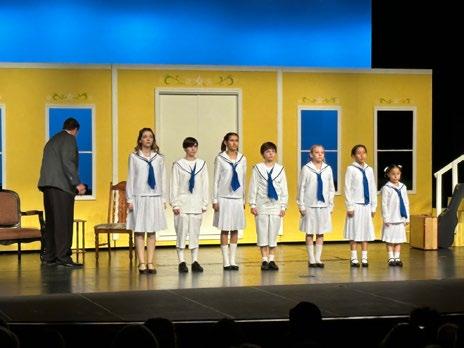
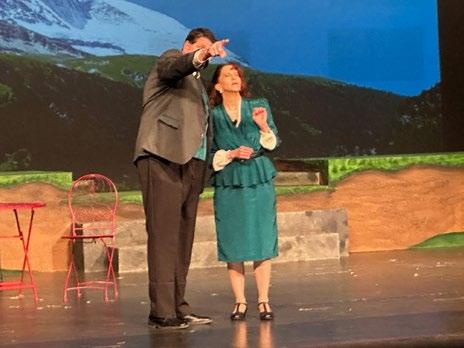
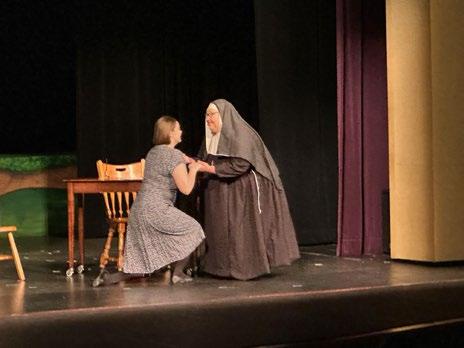
6 PULSE PUBLICATIONS May 2024
Old Time Fun AT THE MOJAVE RIVER VALLEY MUSEUM
By John Wease

WE WHO LIVE IN OR NEAR BARSTOW are blessed with a surprising number of museums. The famous Harvey House is home to three museums. The Western America Railroad Museum has a large collection of everything railroad for the fans of trains. The Mother Road Museum has a fascinating assortment of memorabilia of the Historic Route 66. Upstairs you can visit the Goldstone Deep Space Communications Visitor Center for information about Goldstone, NASA, and our current and future space programs. The Harvey House itself is a living museum that transports us back to the golden age of rail travel. All of these museums do a fine job representing their particular areas of interest. To see an all-encompassing display of artifacts that represent the history, culture, and industry of our area, you really must visit the Mojave River Valley Museum.
The Mojave River Valley Museum is the oldest of our museums. The museum association was founded by the Barstow Women’s Club in the 1960s. In 1966, the first museum building of the Mojave River Valley Museum Chapter of the San Bernardino County Museum Association. At six hundred square feet, the building was almost smaller than the name. The museum later became independent and has expanded to four thousand square feet.
Inside, you can find our history going back to prehistoric times with a collection of locally found fossils and stone tools from the Early Man Site. Cultural displays include the indigenous people, early explorers and pioneers. Our important industries are well represented with many displays of our agriculture, mining, railroad, and military history. Outside you can see a collection of items too large to
fit inside. The old iron jail from Daggett, a log cabin, tractors and other agricultural equipment, and a railroad “drovers’ car” are all on display.
On April 20 the Mojave River Valley Museum hosted their annual open house and bar-b-que. The open house is the best time to visit as all of the outdoor displays are open. We were able to walk through one of the few surviving drovers’ cars, that was used as quarters for the ranch hands while accompanying their cattle on their rail journey to market. It was equipped with bunks, seats, and a wood stove at each end. It looked luxurious in comparison to the several months long cattle drives romanticized by Hollywood.
The log cabin is set up as a blacksmith’s shop. A skilled blacksmith was demonstrating how metal items were heated and hammered into existence back in the days before the big box stores. To see square-shank nails, each one carefully hand-made, never cease to amaze me.
There were other demonstrations of the “good old days” of bygone eras. My personal favorite was the Dutch oven sourdough rolls cooked over charcoal burners. The Walkers are there each year, explaining the process of making sourdough bread using starter that is over one hundred years old. They were generous with samples and even had home-made butter and jams to spread on top. They even gave my wife, Susana a small sample of the starter to start her own.
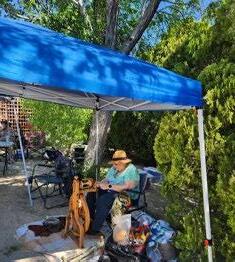
Nearby a friendly member of the Gold Prospectors Association was demonstrating gold panning. Another person demonstrated the use of a spinning wheel. Susana was fascinated with a demonstration of making rope. She made two pieces to bring home. If you call and she tells you I am tied up at the moment, please have someone stop by and check on me.
The Mohahve Historical Society had an interesting information booth. And, yes, that is how they spell it. I believe the Mojave spelling we commonly use was a product of the Spanish explorers’ phonetic
spelling. I had the pleasure there of meeting Marcy Taylor. She writes the Marcy’s Musings column each month for the Pulse. The “good old days” might have been considered enjoyable by some because of “moonshine.” And, no, not the light from a full moon. Moonshine was the product of distilling various grains in home-made stills to produce alcoholic beverages. The Hooch Hut was there to make sure that part of our history was not lost or forgotten. They offered small (very small) samples that were, surprisingly, quite nice. It was not of the “White Lightning” type of corn liquor popular in the movies. Interestingly, it is not illegal to make beer, wine, or distilled spirits. Only selling it without the proper taxes is illegal. This was true during Prohibition as well. During prohibition, drinking was never illegal, only the manufacture and sale. The bar-b-que by J & S Specialties has become a welcome tradition. The food is delicious and servings are large. It was a pleasant day to visit the museum, view the demonstrations and displays, and eat some tasty food. If you missed the open house, you can still visit the museum daily. They are open 11:00 a.m. until 4:00 p.m. every day except holidays. Admission is free. They have a large number of books in their bookstore and a gift shop. The Mojave River Valley Museum is located at 270 E. Virginia Way in Barstow.
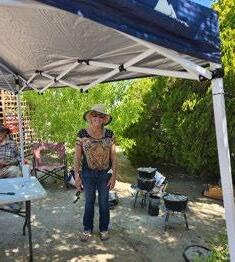
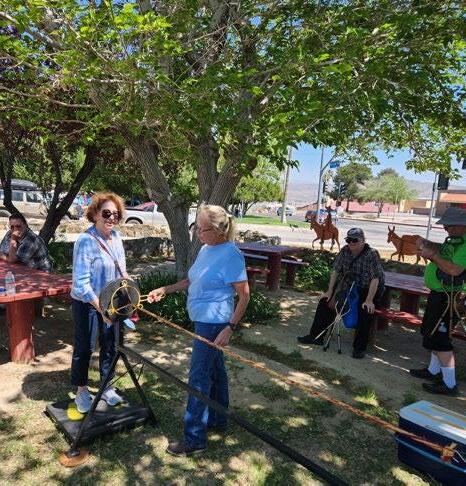
7 PULSE PUBLICATIONS May 2024


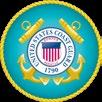



NEWS 4 VETERANS Spotlight on High Desert Marine Lee Kinney
MARINE GRUNT, infantry officer, scholar, university professor, world traveler, retiree: which title describes High Desert Marine Lee Kinney? All of them. Lee’s past 60 plus years have been filled with the stuff bestselling novels and blockbuster movies are made of. What follows here may not do justice to a life devoted to defending liberty, enhancing academia, and embracing the cultures of the more than 100 countries he’s visited.
Lee is full of interesting and entertaining anecdotes. His story begins when he joined the Marine Corps in 1960 leaving his Illinois roots behind him and rarely looking back. He spent nearly seven years in the enlisted ranks, including a tour in Vietnam, before being selected for Officer Candidate School (OCS). He admits his time at Quantico is most memorable because he was the only enlisted Marine among 750 candidates and he was older than most of them. When he compares the difference between Boot Camp and OCS, Lee admits that officer candidates are treated differently than recruits. He remembers that it was not as belittling as recruit training, however he is quick to tell you that OCS was a life-altering experience. Because of his Marine Corps history, he was often used as an example during training. He recalls that one of his instructors was a former roommate of his. That instructor was not as accepting of Candidate Kinney as he was of Sergeant Kinney.
Serving two Vietnam tours and being wounded three times is just a glimpse at Lee’s combat record. Force Reconnaissance (FORECON) is one of the Corps Special Operations Capable Forces (SOC). As a noncommissioned officer (NCO), he was a member of the 3rd FORECON, performing recovery dive operations in the rivers of Vietnam checking bridges for explosives, exemplifying FORECON’s motto “Celer, Silens, Mortalis” (Swift, Silent, Deadly). After jumping out of planes more than 200 times, Lee nearly lost his life on one mission when his parachute malfunctioned. He returned to Vietnam as a platoon commander with 5th FORECON at a time the war was at the height of combat action. Lee was wounded and spent a month in the Army hospital at Cam Ranh Bay. While infirmed, he grew weary of the tranquil, but dull, atmosphere and was anxious to return
to his unit. “I couldn’t get any answers as to when I would be released so I went UA” (unauthorized absence) Lee says with a gleam in his eye that all Marines recognize as doing “whatever it takes.” He traveled three days hitching rides in planes, jeeps and assorted military vehicles to get back to his Marines. “What were they going to do - send me to Vietnam?” he smiles.
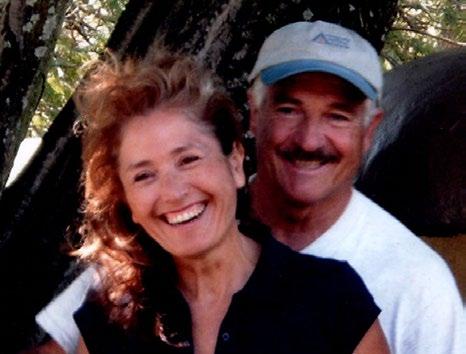
After rejoining his unit, Lee received his third purple heart when a grenade injured him so severely that he was not expected to survive. He recalls that he was given last rites (the prayers administered to one who is in grave danger of dying). He was sent to Fitzsimons Army Hospital near Denver where he underwent multiple surgeries to mend his broken back and mangled body. Lee spent two years in the hospital receiving medical care and rehabilitation along with many fellow military casualties, many of whom had lost limbs. He envisioned the rest of his life with his legs encased in braces and made a profound decision to request that his badly damaged leg be amputated. Although medical personnel told him the procedure was not advised, he believed that he could walk better with a prosthesis than the braces. By his own choice, Lee lost his useless leg and received a new strong artificial limb. His rehabilitation was successful; he made a full recovery. He enjoys sharing the story of making numerous parachute jumps as an amputee with an Army Special Forces unit while still hospitalized.
The Marine Corps policy at that time was mandatory retirement for amputees. However, Lee was not done with his military commitment and, with the same determination that got him back to his unit in Vietnam after being wounded and in the hospital, he requested mast and

petitioned the Corps to allow him to remain on active duty. He successfully completed the physical fitness test (PFT) consisting of pull-ups, sit-ups and a 3-mile run. Lee is the first infantry officer to return to full duty with a prosthetic limb. He finished his Marine Corps career in 1971 as a company commander at Camp Pendleton, retiring as a Captain.
”The Marine Corps taught me discipline and how to maximize my time” says Lee, “And I believe there is life after the Marine Corps.” He took advantage of the educational opportunities he earned for serving his country and enrolled, first in Victor Valley College, then California State University San Bernardino. Four years later, he graduated valedictorian of his class with two Bachelors degrees -- Anthropology and Geography -- and was selected for graduate studies at Harvard. While at Harvard, he did field work in Africa; an area of the world he fell in love with and has traveled to 18 times. After earning two Masters degrees, Lee began a long teaching career at Cal State University. He also was a professor at Central Texas College where he taught active-duty military personnel, deploying with his students six times to the Persian Gulf.
Lee and his wife, Alicia, whom he met at Cal State, are avid travelers and have journeyed to many countries. In fact, they were married in Kenya while standing on the Equator, on the continent of Africa. Lee totally retired 15 years ago and embraces the adage “Quit worrying about dying and put emphasis on living”.
Staying true to this pronouncement, Lee and Alicia are rarely home. They are either getting ready for a trip to some exotic and/ or interesting place or just returning from their latest venture. As busy as they seem, they found time to build a new home in Spring Valley Lake - a beautiful Pueblo style house which has plenty of space for the many artifacts and furnishings they have discovered and brought back from around the world. They are surrounded by a collection of precious memories and their home is a testament to their adventurous lives.
A Marine grunt, infantry officer, scholar, university professor, world traveler and retiree? Yes, Lee Kinney is all that. And in his words “I am enjoying my life to the fullest.” Aye, aye, Sir. Well earned!
8 PULSE PUBLICATIONS May 2024
A Chat About Parkinson’s
Depression is part of the deal, but misery is optional.

IT WAS ONE OF THOSE MORNINGS. I felt lone and lonely. Mind you, I was not alone, but the feeling was there. Then the poor-me pity party began. Did you ever throw a party and no one came? Yeah, me, too. This was one of those parties. I know better. I know that I am so blessed in so many ways, and I am grateful. The key is to recognize the good –and there is so much of it, no matter who you are--and then to see it clearly enough to shove the other stuff in the background with “dumb things I don’t need to acknowledge.”
Depressions in Parkinson’s disease is common, I’m sorry to say. The reduced dopamine level found in Parkinson’s patients affects the balance of several other neurotransmitters in the brain, including serotonin, which plays a role in depressions. And no, it is not always a voluntary pity party that brings it on, but there are ways to lighten the mood. Check with your movement disorder specialist about ways to combat depression. It can increase your quality of life mentally, emotionally, and physically. A quote that seems to apply:” You cannot prevent the birds of sadness from passing over your head, but you can prevent their making a nest I your hair.” Of course, you are bald, like most of the men in my family, you will need another quote, which is provided at the end of this column.
by Ann Miner
The late author, Tim Hansel, was an avid outdoorsman who had a terrible accident while hiking in the mountains. He lived with pain from that fall for the rest of his life. His attitude, however, is one that can teach us all. In his book, “You Gotta Keep Dancin’”, he gives the freeing message that, no matter what your circumstances, you can be joyful. I met him several times and he was an inspiration. My favorite memory is learning the Superman call backwards from him and then “performing” it together for a crowded conference.
I recommend all his books. They will inspire you and make you laugh. That sort of reading takes my mind off throwing a pity party.
About that quote for the fur-challenged, Michael J Fox offers this: I often say now I don’t have any choice whether I have Parkinson’s (or am bald), but surrounding that non-choice are a million other choices that I can make.”
Be good to each other. Keep looking up. And remember, it’s just a bad day, not a bad life.”
The Parkinson’s support group is for anyone. We meet at 1:00pm on the first Monday of the month at the Choice Medical Center, 19111 Town Center Drive (by Jess Ranch), Apple Valley. For information, call Ann at 760-954-2859.
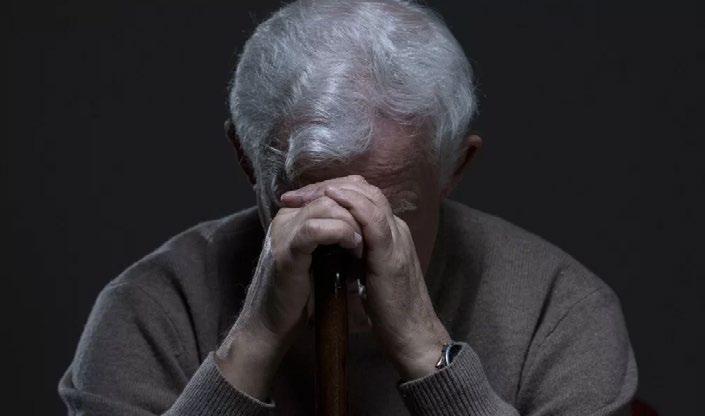

9 PULSE PUBLICATIONS May 2024
Gem Hunting in CALICO
IHAVE BEEN A FAN OF CALICO GHOST TOWN for about as long as I can remember. I vaguely remember visiting there as a very young boy around 1955. Although I live conveniently close, I seem to only make it there for some of their special events. And then, sadly, I am there for an article about the event so I am busy taking photos and hurrying from one activity to another. I wrote an article about the California Days event that appeared in the March issue. In the article I mentioned that Calico was a great place to buy unique gifts.
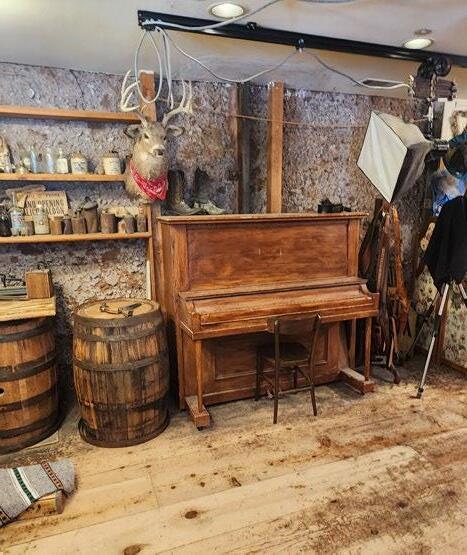
Now I consider myself, like most people, to be pretty normal. I love to receive praise for my articles. And, like most “normal” people, I’m not that fond of criticism. When someone told me the days of unique, handcrafted items were long gone at Calico, I knew, as a normal person, I just could not be wrong. I decided to see for myself. Surely it could not be that only mass-produced souvenirs were available. I arrived early on a weekend morning and found the ghost town to be, well, a ghost town. I knew I would need energy to walk the town and investigate so I began by having breakfast at the Calico House Restaurant. The meal was great, as was the service. The restaurant captures the Old West feeling well and prices were not the inflated, amusement park prices I
By John Wease
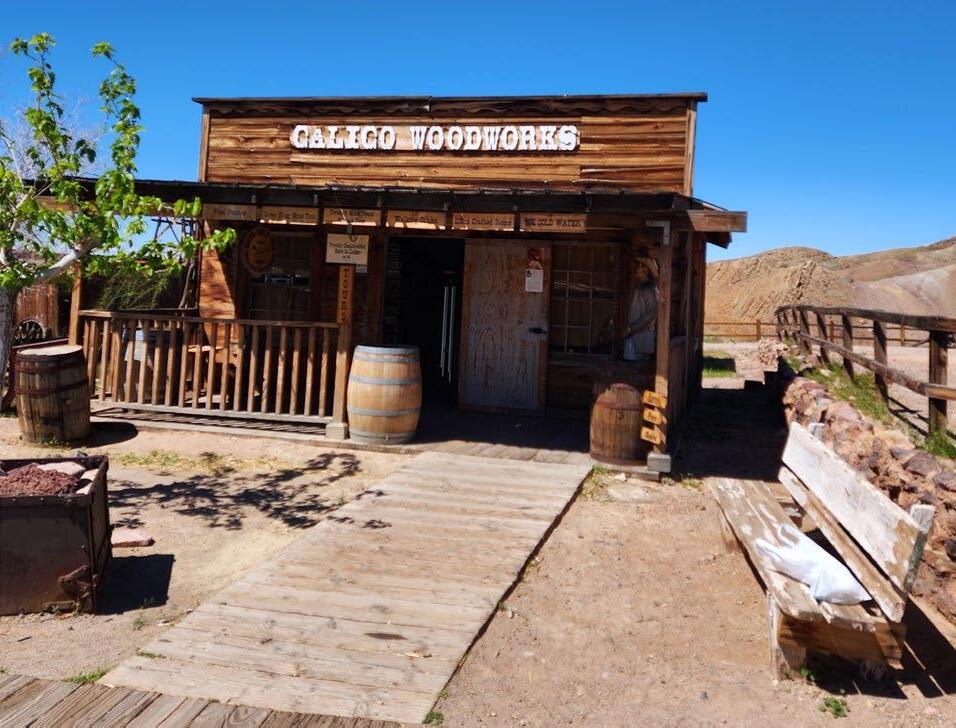
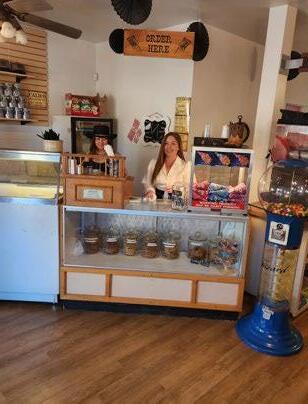

expected. The Calico House is currently the only restaurant in town. Lil’s Saloon serves pizza and hot dogs for those that prefer more casual dining.
Lil’s Saloon is an interesting place to visit. It is one of the few original Calico buildings and was Doctor Rhea’s pharmacy building during Calico’s 1880s heydays. You enter through swinging doors to find a saloon right out of the Old West. Pictures of famous gunfighters line the walls. An extensive collection of firearms is on display as well. The pistols are replicas but representative of the arms used by the pictured gunfighters.
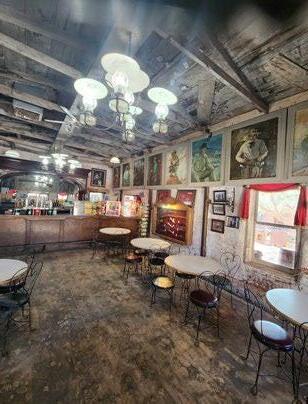
Daryl Schendel, the owner, was on duty that morning. I know Daryl as the owner of the Conversions Firestone business in Barstow and his involvement with the Daggett Historical Society and the Mojave River Valley Museum Association. As a Calico business owner for some sixteen years, he is quite knowledgeable about the history of Calico and was able to answer any questions the town visitors had. When I mentioned I had researched Calico’s history for my writings he gave me an oral quiz. I have not received my final grade but I hope I passed.
In fairness to my critical reader, there
10 PULSE PUBLICATIONS May 2024
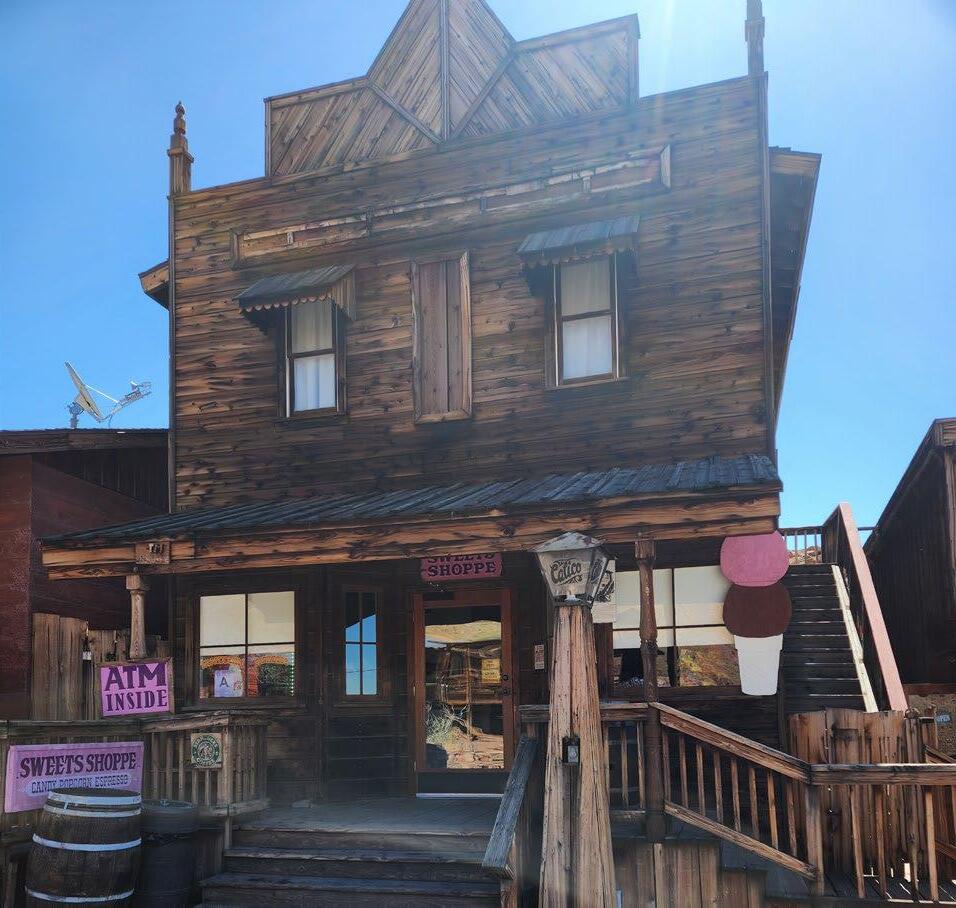
are several businesses that just sell the mugs, tee shirts, and mass-produced Calico souvenirs. In fairness to these stores, many of the visitors were wearing Calico tee shirts, purchased the day before. A surprising number of visitors I spoke with had come for the weekend and had stayed locally overnight. They were back on Sunday to see the things they had missed the day before. Most of the visitors were tourists, many were from foreign countries. Maybe these Calico souvenirs were just what they wanted.
In my quest to find handcrafted offerings, I was pleased to find the Calico Woodworks store. There was a delightful mix of wooden items. Colored images burned into wooden panels through some form of computer-controlled magic depicting the famous and infamous of the Old West as well as many other choices of pictures lined the walls. Hand-made wooden boxes with the same type of images can be purchased empty, to hold your own treasures, or with jigsaw puzzles of the image on the cover. And, since it is computer magic, any image can be scanned to create custom art pieces. Hand-turned wooden bases are made onsite to hold oil lamps. Electrified versions are also available. A table-top wood lathe is used both to make these lamp bases and for wood-turning demonstrations. Another pleasant surprise was finding Ronni Burgess behind the counter. I know Ronni as one of the docents at the Mojave
River Valley Museum in Barstow. I had no idea she was a skilled woodworker as well.
For a really unique souvenir of your visit to Calico be sure and stop in at the Calico Photoshop. The skilled photographer has a studio with period correct props and a wardrobe to transform his customers into their favorite characters of the Wild West. The Calico Saloon, an old piano, an antique bath tub, and a saloon card table are available choices. Imagine Mom dressed as a saloon girl as Dad sits at the upright piano, or Junior at the card table hoping to not be dealt aces and eights. And, if you want to include your canine best friend, pets are welcome. The photos are digital so travelers can select which photos they wish to purchase and receive them digitally anywhere in the world. Or, they can be bought framed in handcrafted wooden frames (from Calico
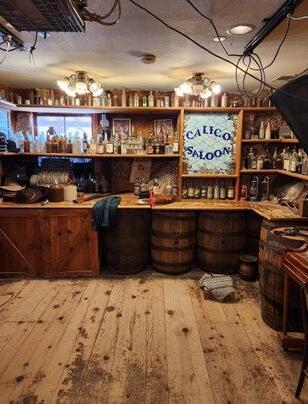

Woodworks) or unframed, or added into wanted posters or old-time newspaper articles, just to add to the fun.
The last shop I found with hand made items did not sell long-lasting souvenirs like coffee mugs or tee shirts. In fact, many of their offerings won’t last long at all. The Calico Sweets Shoppe makes fudge in many flavors as well as a variety of toffee nuts onsite. They also have an ice cream counter and a large selection of “store bought” candies. Somewhat surprisingly, the Sweet Shoppe sells a lot of flavored pickles and specialty hot spices. And, for those that want to wash it all down with coffee, they have Starbucks.
Sadly, some of the store owners I met in past years did not survive the Covid lock-downs and are no longer there. The tour buses are just starting up again now, so business owners are hopeful. They could use community support. There are hand-crafted and unique “gems” still to be found. There is a lot of talk about the growing number of “cottage industries” producing products at home. Calico may be just the place to market your unique products. So, visit Calico. Support the businesses there. Show the business owners your hand-crafted products and discuss adding them to their shelves to your mutual advantage. Help keep this important part of our local history alive.


11 PULSE PUBLICATIONS May 2024
Beyond Companionship: How Pet Therapy Changed My Life
By Brisa Alfaro
HAVE YOU HEARD that spending time with animals can be a significant factor in healing from trauma, according to studies? I didn’t, but before I get into that, let me tell you a little about who I am. I’ve lived in the High Desert for many years as my parents own Las Brisas Family Restaurant in Apple Valley. I grew up in the restaurant business and when I was 32 years old, I became a Pons Stroke and “Locked in Syndrome” survivor. In other words, I was trapped within my body, unable to move or communicate, yet I remained fully conscious despite appearing comatose. I was given less than a 1% chance to recover and during this battle for my life, I made the decision that I would stop at nothing to overcome this incredible challenge. I had to ignore any doubts that I and others had. In the early days of my recovery, I would hear how “lucky I was to have survived to this point.” With very few cases of “Locked in Syndrome” reported annually worldwide, and fewer successful cases to look to for inspiration, I had to become that person I was looking for. Through micro-steps of improvements, I was determined to not let this be the end of my journey. To say that I was not fazed by the alarming statistics or odds, would be a lie. Despite my fear, I pushed forward with a combination of love, caution and courage.
Although I have fully recovered physically, I continue to grapple with numerous invisible deficits. The incredible support from my family, friends and mentors, coupled with activities like exercising, earthing, meditation, praying, reading, writing, and therapy have allowed me to share my challenges publicly as a speaker and a writer. That being said, my dog Gucci had the most profound impact on my healing and recovery journey. The circumstance leading up to Gucci

becoming my emotional support dog happened as I was pushing through recovery “physically” speaking. I was ignoring what was going on inside of me and found myself struggling and overwhelmed with many invisible challenges. I remember thinking, “How can anyone help me with this? I can’t even put into words what I am feeling.” My doctor noticed my symptoms and suggested that I look into therapy to help manage the PTSD and that’s when I was introduced to pet therapy to cope with anxiety, depression, and more. “I already have a dog!” I shared with my health care provider. She asked me if I usually felt unwell while sitting at home with Gucci. “No”, I responded and shortly thereafter, Gucci was licensed and ready to travel with me to keep me cool, calm, and collected anytime, anywhere and at any moment.
Several years ago, I launched my speaking and coaching business and I will admit becoming an entrepreneur after sustaining a massive brain injury hasn’t been easy. Like most brain injury survivors, we tend to deal with insomnia, anxiety, depression, mood swings, PTSD,
memory issues, and a myriad of other challenges that may include recovery downtime from surgeries.
I am now in year 10 of post-stroke recovery and I am super proud of the progress I’ve made with Gucci by my side. She possessed an almost magical ability to lift my spirits and calm me.
Our roles eventually reversed, and in late 2023, my Gucci girl took her last breath. Being there to support her through her through her journey was an emotionally profound experience, fueled by the unconditional love that she provided to me for 17 years.
During this month of mental health awareness, I encourage you to consider adopting or training a support pet to discover the bond and transformative impact that is beyond companionship.
Some Angels choose fur instead of wings.
Brisa Alfaro Stroke Survivor, Speaker, Mentor

12 PULSE PUBLICATIONS May 2024
Your banner ad could be here! Let PULSE be the voice and the door knocker for your business!!
LifeThe Interview
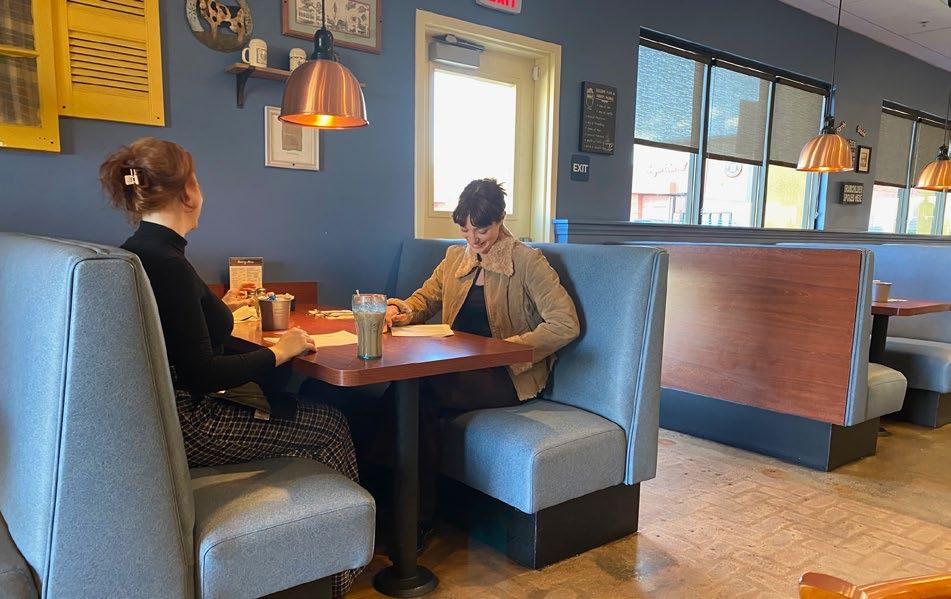
I’M INCREASINGLY SENTIMENTAL anymore. It doesn’t take much to push me back to those days before when life had been simpler and the issues confronting me had been less about what was the right thing to do and more about what to do just to fill a single day.
I was so dumb and young at seventeen but weren’t we all? I took ballet lessons at the Cherry Hill Mall in Cherry Hill, NJ because I actually thought I could try out for the football team at the University of Oklahoma. Heck, I was barely a secondteam player on a team that was filled with giants and ranked, I understand, fifth in the country by Scholastic Magazine. I even
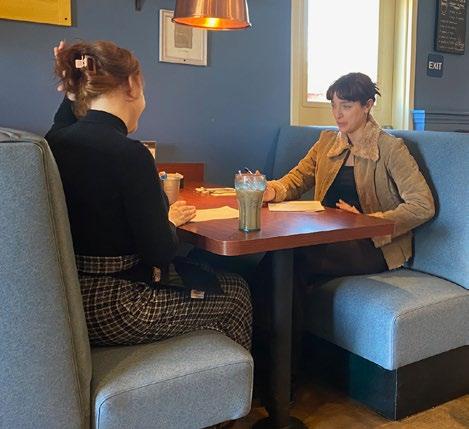
got a letter jacket and I wore it once when I cut school and went to Philadelphia to show off.
Except it didn’t feel right to wear it because I was never sure I deserved it just for showing up. It wasn’t until I joined the Marines that something, other than surfing at the Holgate dunes, felt right because I had earned it.
But I impose upon your patience and any nostalgia you might feel because of a girl I saw interviewing for a job last Friday. It was in the morning, at Corky’s in Apple Valley, and she was seated in a booth near me. I was there for a Roundtable meeting of friends from the writer’s club. I was drawn to her not so much because she was pretty. She was definitely that.
She had a clean and fresh look about her, which I realized you’d expect from someone applying for a job. But everything about her looked natural and not painted on just for the occasion. In her case, less was more and I imagined she looked that way anytime she left her home and entered the world.
Watching her fill out her application reminded me of the first time I applied for a job. It had been as a stocker at a woman’s clothing store at the Willingboro Plaza in Willingboro, NJ. It was called Baker’s and
By J.P.Garner
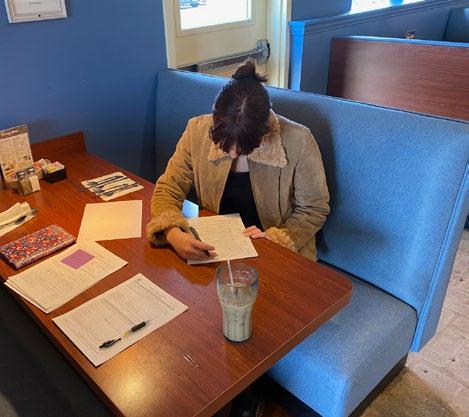
despite the fact my mother worked there and had recommended me, I was nervous as hell. I didn’t know what to wear, or how to act despite the coaching I received from my father, and I had the curse of most teens: a few pimples. I applied English Leather to me three different times.
Gawd, I must have smelled to high heaven. Whatever.
We’ve all been there, at that first job interview. Anxious and eager. Above all eager. I was sure I had bombed but I didn’t. It is like that with most things we have done for the first time. There’s an innocence about it when you’re seventeen. Or even, I’m happy to admit, when you’re older. Especially if you’re a romantic or idealistic.
The days are colored differently for us. Sunrises and sunsets have more meaning. Even a first kiss at sixty-four has the same enchantment as it did at fourteen. The only thing we do without trepidation is being a grandparent. No coaching is needed for that.
But the woman interviewing for a job was most kind to consent to let me write about her and take her picture. Her name was Justine. I was most grateful to her for reminding me of a time when everything was new and even something as insane as thinking I could play major college ball seemed possible.
She said she was nervous, but she had a winning smile, so I doubt she bombed.
13 PULSE PUBLICATIONS May 2024
Slice of
Big Bear Valley Historical Museum: A Tale of Two Cities
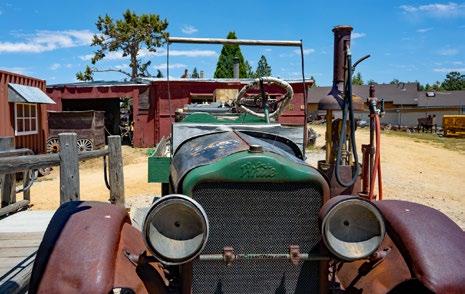
HAVE YOU EVER WONDERED if the vastly different cities of Big Bear City and La Quinta, California, could possibly have anything in common? One is high in the San Bernardino mountains , a few minutes from Big Bear Lake, and the other is near the Santa Rosa mountains in the low desert, approximately an hour’s drive to the largest body of water in the desert, the Salton Sea. Wonder no more. At both locations, exclusive resorts were built to promote new developments, and to attract Hollywood stars and perspective homeowners to its natural beauty. In Big Bear, Austrian-born real estate developer Harry Kiener built the Peter Pan Woodland Club (no longer standing) near the present-day Big Bear Airport. It was designed and constructed in 1930 by Guy Maltby, owner of the Bear Valley Milling and Lumber Company. Kiener chose the name Peter Pan because he felt the beauty of Big Bear Valley equaled the magical beauty of “Never Never Land.”
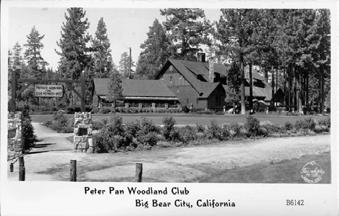
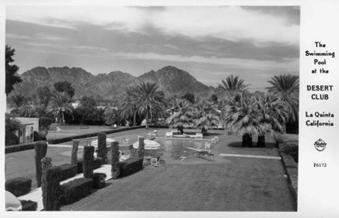
According to La Quinta Museum historian, Kim Richards, both La Quinta and Big Bear City share an amazing connection to Harry Kiener, Guy Maltby, and the Peter Pan Woodland Club. Kiener, of the Big Bear Land and Water Company, decided to make a sister club to the Peter Pan Woodland Club and chose the Desert Club (no longer standing) in La Quinta, east of Palm Springs.
He hired Guy Maltby who built and lived in the Lumberyard building next to The La Quinta Museum –which is still standing, to get that project started. The Peter Pan Woodland Club and the Desert Club offered reciprocal privileges year round. The proverbial best of both worlds.
In the end, both resorts would even suffer similar fates. The Peter Pan Woodland Club experienced a devastating fire in 1948, completely destroying the clubhouse. It never re-opened. The original but smaller clubhouse built in 1927 south of Big Bear Boulevard was raised up and hauled by trucks down the hill to the golf course northwest of the Greenway and Country Club intersections and placed next to the resort’s swimming pool. It re-opened as Peter Pan Rancho but never recaptured the glory of the Woodland Club. The Desert Club burned down in 1989 but for very different reasons. The city of La Quinta, believing that it would never have the resources to restore the site it had been donated, allowed the California Department of Forestry and local volunteers to burn the structure for firefighting practice. The city later created a community park on the site named after the former owner of the Desert Club, Fritz Burns.
Bonus fact: Harry Kiener was the fatherin-law to American novelist Louis L’Amour, best known for his fictional books about the Old West. Louis and his wife, Kathy, had a 60+ acre date and citrus “ranch” behind The La Quinta Hotel (no relation to The Desert Club) until the property was sold in the late 1960s.
Now, back to the mountains. No trip to the Big Bear Valley is really complete without a visit to the Big Bear Valley Historical Museum. Highlights include a furnished 1875 log cabin, the Shay Ranch cowboy bunkhouse, memorabilia from Hollywood’s glamorous golden age and its connection to Big Bear, a working blacksmith’s shop, Well’s Fargo office, the Juniper Point General Store, Post Office, carriage shed, 5-stamp mill and more.
 By Jaylyn And John Earl www.thedesertway.com
By Jaylyn And John Earl www.thedesertway.com
Big Bear got its name due to the large number of grizzly bears that once roamed the area. Although grizzly bears went extinct in the valley at the turn of the 20th century, there are still thousands of black bears found in Big Bear Valley.
The museum offers hands-on gold panning at their sluice box to experience how miners used to separate gold. Sluicing is a method of separating and recovering gold from the placer gravel by the use of running water. Gold is caught or trapped by riffles.
Burros were introduced to the Big Bear area between 1900 and 1940. During this period, burros escaped from miners, movie sets, fox farms, and ranches. The present population of 60 wild individuals most likely became solidly established as a result of burros that escaped or were released from annual burro races in and around Big Bear City beginning in 1955.
The Dam Keeper’s Mule Barn was built in 1885. It sheltered his burros kept by the dam keeper near the dam.
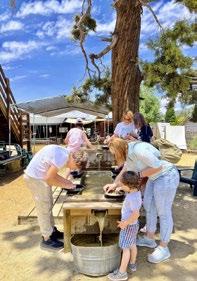
In October of 1890, the historic Dam Keeper’s House was built using hand-cut granite blocks from the same quarry that provided the stones for the first dam. For nearly a century, this was home to over a dozen dam keepers and their families. The famed Bill Knickerbocker and his family were early residents between 1909 and 1918. After the Municipal Water district purchased the lake in 1977, and water would no longer be released for irrigation, there would be no need for a resident dam keeper.
We enjoyed looking at an 1880s 5-stamp mill, which was used to crush ore from mines. Californian stamps were based on Cornish stamps and were used for the Californian gold mines. In these stamps the cam is arranged to lift the stamp from the side, so that it causes the stamp to rotate. This evens the wear on the shoe at the foot of the stamp, which improves efficiency.
We really enjoyed a personal tour given to us by the museum’s curator, Jonni and her sister Karrie. Jonni is fascinating and able to talk about every exhibit in lively detail. Her roots in Big Bear go back an impressive number of decades. Much of her family’s belongings, even her Dad’s high school letter sweater, is on display. It is evident that she and volunteers have done an excellent job capturing the past. By the way, you may spy with your little eye the name of Mel Blanc in the background. Did you know Mel
14 PULSE PUBLICATIONS May 2024
Blanc lived in Big Bear most his life? In fact, “The Man of a 1,000 Voices” served as the honorary mayor for 33 years.
The Big Bear Valley was home to the indigenous Yuhaaviatam, a clan of the Serranos, for about 2,000 years. The name ‘Serrano’ or ‘mountaineers’ was given to the natives by Spanish explorers. The Serrano Indians are the indigenous people of the San Bernardino highlands, passes, valleys and mountains who share a common language and culture. You will find a Yuhaaviatam encampment, donated by the San Manuel Band of Mission Indians and the James Ramos family, outside the Shay Bunkhouse. The museum property is very near the site of a Serrano creation legend.
The Cienega Large Cabin is a hunting cabin built in 1875. It is the oldest building in Big Bear Valley. Today, it displays a typical home of the late 1800s.
Necessary cooking implements, rocking chair, spinning wheel and a Holy Bible were some of the many items you would find in a well-stocked pioneer family’s cabin. Other creature comforts included beds with handsewn quilts, wood tables, a wash basin and lanterns; all authentically represented in the museum.

Built in 1919, the Camp Juniper Point Store and Minnelusa Post Office was originally located on North Shore Drive, on Juniper Point, which was known as a summertime camp and resort. The post office was in operation until 1940.
You will see all manner of dry goods and merchandise old timey general stores used to have on display. General stores weren’t just a place to buy essential items but also served as a community hub where local community news and gossip was exchanged amongst townsfolk and strangers, a treat when children were occasionally rewarded with penny candy, and a place where mail was sent or eagerly received.
Years ago a single cent could satisfy a child’s sweet tooth. Penny Candy made its debut sometime circa 1896 with the Tootsie Roll at Woolworth’s Five and Dime. When the chain closed its U.S. stores in the 1980s much of the popularity of penny candy died out.
What is Delaware Punch, you may ask. Delaware Punch was created by Job Daniel
Rubio Delgado in Delaware, Ohio, in 1913. The fruitbased brand is currently owned by The CocaCola Company, but has been discontinued. The beverage is difficult to find, but is still served in some restaurants in Houston, Texas.

The utterance of the word ‘gold’ was usually all it took, and the rush was on, probably before most prospectors finished unpacking their picks and shovels. Just up a pretty good road from the Doble town site is the remnants of the Lucky Baldwin mine and, beyond in Holcolmb Valley, the location of the famous kidnapping scene from the Paramount Pictures film, Paint Your Wagon (1969) with Lee Marvin. Our photo depicts a screen capture from the movie matched with a photo we took where the scene was shot.
The Doble Schoolhouse is a recreation of a 1901 building that once stood in Doble. All that remains of Doble, is the Doble Cemetery. Before it was Doble (pronounced, ‘Doe-bull’) , the place was known as “Bairdstown.” It came to life after the Carter brothers filed four gold mining claims in 1873, on the mountainside that now wears their name.
Most days you will see a working blacksmith demonstrating his skills with iron, tools and fire. On the day we visited, blacksmiths were making ice cream spoons for children in the audience.
Blacksmithing is the art of hot and cold forging metal using tools like a hammer and an anvil to make objects, like hinges, nails, hammers, decorative art and knives.
A skilled blacksmith can judge just how hot and malleable a piece of metal is by its color-white, yellow, orange, red or purple. The softened iron is shaped or turned into wrought iron by pounding it against a heavy steel anvil.
Here, the curator of the museum, Jonni Vindiola, demonstrates safe weapon handling at the Wells Fargo exhibit, which features the impressive and effective coach gun (12 and 10 gauge being the most common at the time), and important memorabilia from the era. After the discovery of gold in California, Wells Fargo became a business that connected the East with remote gold fields out West. Henry Wells and William Fargo met in New York City on March 18, 1852, and started Wells Fargo, and offered banking, express, and mail delivery services to merchants and miners. This structure, built in 1916, was originally at the Shay Cattle Ranch. The bunk house
features living quarters, saloon, barbershop and dentist, with life-size mannequins recreating scenes from the past.
Barbers often took on the role of dentist in addition to their many other skills such as hair cuts and shaves, due to their expertise with sharp instruments & dexterity when tooth extractions needed to be performed. There is also a Peter Pan Woodland Club exhibit at the bunkhouse.
A recreation of a prospector’s camp is on the museum grounds. Miners were willing to endure physical hardships in exchange for the bounty that a strike of gold could offer. Some prospectors worked by themselves or in small groups while others established entire mining companies to be able to reach the inner depth of a lode.
Big Bear Valley Historical Museum is open Memorial Day weekend through the second week in September, Saturdays, Sundays, Wednesdays and Holiday Mondays, 10 a.m.-4 p.m.

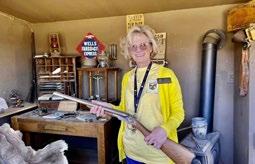
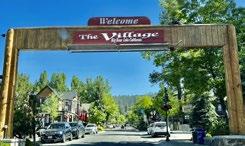
While you’re in Big Bear, we recommend you visit The Village, where you will find restaurants with live music, old fashion candy and ice cream stores, assorted shops and interesting places to stop by. And of course, please drive around to enjoy viewing Big Bear Lake from many scenic areas at various points around the nearly 7 miles-long, and 1/2 mile wide lake. Big Bear is famous for its ski resorts in the winter but there are lots of activities to take part in almost all year round. There is even a zoo. For pilots, Big Bear City Airport is open around the clock and equipped for night landings.
Don’t forget Big Bear Lake offers annual Fourth of July Fireworks to the public and it’s a popular event, so come early. For off-road adventurers and day trippers, you may want to tour famous Holcomb Valley to visit Wilbur’s Grave, see where many Hollywood westerns were made and follow the Gold Fever Trail to see Bellville Cabin, hike a portion of the Pacific Crest Trail, visit Bluff Lake Reserve or camp out under the stars. Needless to say, there’s always a lot to do in Big Bear to keep grown-ups and the kiddos entertained. Just remember how it all started.
15 PULSE PUBLICATIONS May 2024
How to maintain a healthier home on a budget
LIVING HEALTHILY remains a primary concern for many today, with homeowners looking to make home improvements with an emphasis on the health benefits of living in an environmentally friendly space.
“When it comes to home improvement, eco-friendly choices can be budgetfriendly,” said Bonnie Lee, Vice President of Property Claims at Mercury Insurance. “Healthy home choices, especially for large renovations, can bring your homeowner cost down and save you money on insurance too.”
The journey to a healthier home begins by identifying areas needing regular maintenance and determining which environmentally friendly products can replace current ones. Here’s a roundup of beneficial and feasible home enhancements:
Breathe easier with clean air
The U.S. Environmental Protection Agency (EPA) states that indoor air can be up to five times more polluted than outdoor air. The air filters in your home’s heating and cooling equipment weed out contaminants like dust and pet dander; however, a dirty filter hampers their efficiency. Regularly cleaning or changing
these filters, especially HEPA filters that cost as little as $30, can ensure clean air.
A costless preventive measure is to maintain the proper functioning of smoke and carbon monoxide detectors throughout your home. Fires and carbon monoxide poisoning are more likely during winter when homes are typically heated, making detector maintenance an important step.
Ensuring safe water
Water filters offer a health-centric and budget-conscious upgrade to homes. Filter pitchers start from as low as $20, and there are more upscale alternatives available like under-sink, countertop or faucet-mounted systems.
Water leak detection devices present another home improvement avenue. These systems alert homeowners when a leak is detected and can automatically shut off the water system if a significant issue exists. Mercury Insurance offers a related discount to eligible homes equipped with these devices.
Environmentally friendly and effective household supplies
Attentions have shifted due to concerns
over the composition of traditional cleaning products, paints, flooring and construction materials. Many homeowners now prefer environmentally friendly alternatives. Look for biodegradable products based on renewable resources. When painting the walls of your home, look for volatile organic compounds (VOC)-free options or those that are Green Seal or GreenGuard certified.
When it comes to appliances, aim for LEED-certified or STAR-rated products for lower energy usage and eligibility for an insurance discount for green homeowners. For flooring, consider alternatives like unfinished hardwood, stone or concrete, and carpets made from natural fibers. Look for non-toxic adhesives to further limit chemical exposure.
For building materials like drywall and insulation, opt for GreenGuard-certified products to avoid hazardous chemicals.
Adopting routine maintenance and home improvements can foster a healthier living environment and offer financial rewards.
For instance, Mercury Insurance provides a 5% green home insurance discount to homeowners with a certification from either the U.S. Green Building Council LEED or the National Association of Home Builders Green Building Guidelines (NAHB).
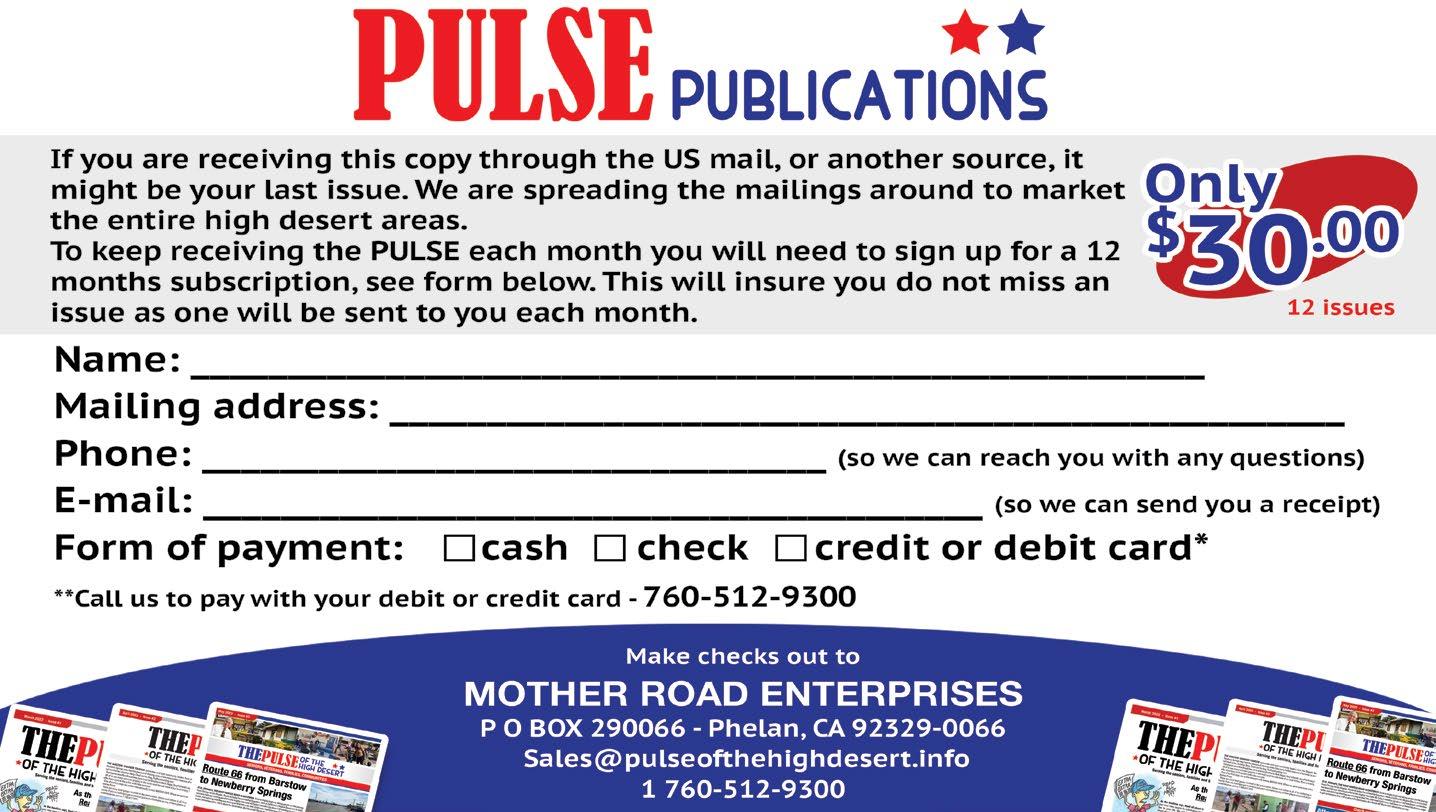
16 PULSE PUBLICATIONS May 2024

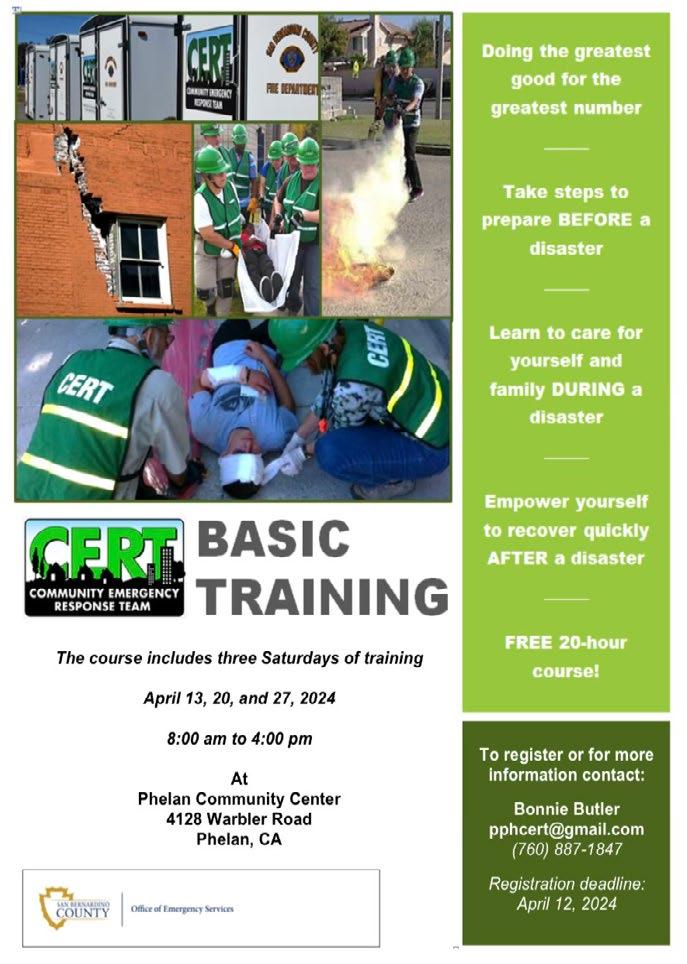
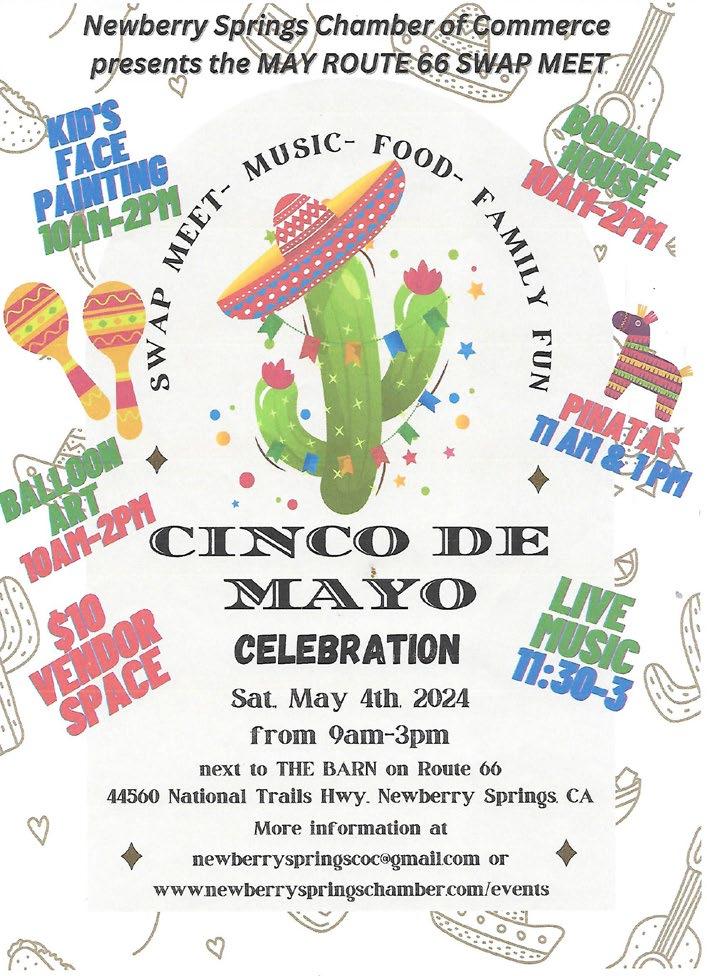


17 PULSE PUBLICATIONS May 2024
For the Love of Ghosts
By J.P.Garner
HER BOOK, SIMONE’S GHOSTS , won the Grand Prize at the Hollywood Book Festival in 2017. It was judged the best of the hundreds of books submitted. She not only was awarded top honors and $1,500 but they fed her too. Her fascination with ghosts began when she was a kid. Possibly with the poem The Highwayman by Alfred Noyes.
A little research reveals that “. . . the poem, set in 18th-century rural England, tells the story of an unnamed highwayman who is in love with Bess, a landlord’s daughter. Betrayed to the authorities by Tim, a jealous ostler, the highwayman escapes ambush when Bess sacrifices her life to warn him.” Below is an extract from Part One:

The wind was a torrent of darkness among the gusty trees.
The moon was a ghostly galleon tossed upon cloudy seas.
The road was a ribbon of moonlight over the purple moor,
And the highwayman came riding—
Riding—riding—
Notice the tale is “ghostly” and as for what an “ostler” is, I had to look that up. It is the job title of a man who cares for the horses of people staying at an inn. But it was this poem and the Georgie children’s stories by Robert Bright that sparked an interest in ghosts that deepened over the years. Later, after leaving her job with Rockwell (by then Boeing) to move to Apple Valley with her husband to care for his parents, finds her writing
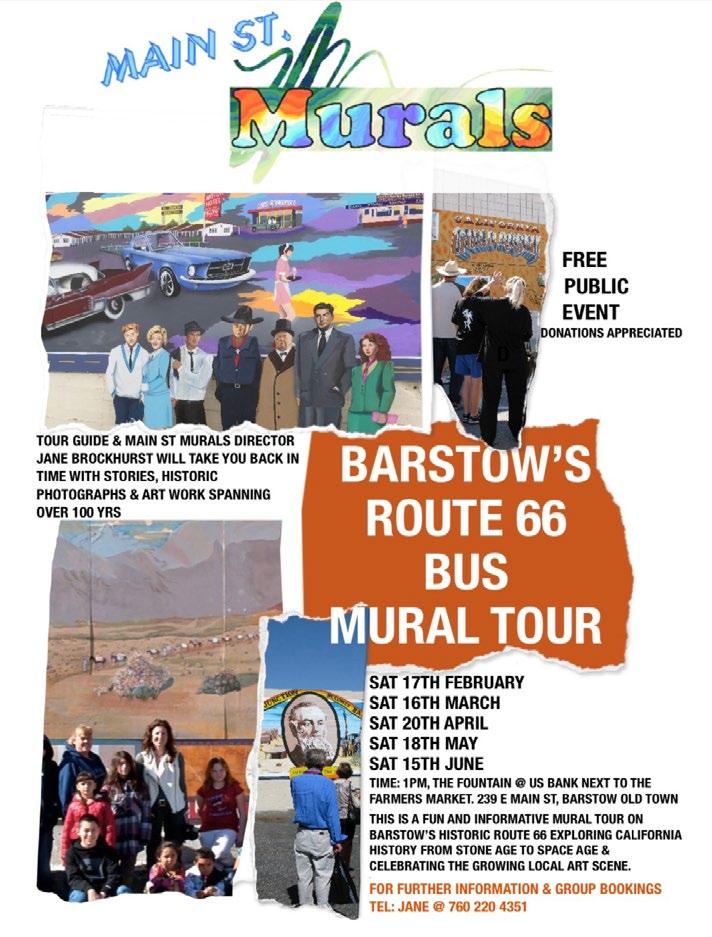
stories involving ghosts.
But before the novels about ghosts, there was the year after she quit her job at Farr, the company that developed the pleated air filter, that she devoted to writing screenplays. As a sixteen-year-old, she wrote a stage play for the Downey Marionette Theater. “Growing up, I auditioned for their children’s theater— no puppets involved—all the time and managed to get into their musicals,” she said of that period. “For the marionette theater, I managed to get roles, even as Alice in Alice in Wonderland.”
She liked theater as well as athletics. She played basketball and volleyball in school, but her favorite game was Speedaway. “It was like soccer,” she explained, “but played with a big ball and you could run with it. I was thrilled when the Marionette Theater produced my play.”
She graduated from Redlands University with what was called a multi-subject major and eventually migrated into an office management job at Farr. Her time at the university exposed her to the many ghost stories involving a little chapel at the Redlands college that had once been a chapel at an Air Force base. It was the inspiration for her novel, Chapel Playhouse.
Her most recent novel is The Haunting of Peter Ashton, which is a work of horror fiction and was a finalist in the American Fiction Awards contest (www.americanbookfest. com)
But her best seller is The Accordo, which is the third book in a series of three books built around the same main character. “The cover sells it,” she says, laughing lightly. Then she added that the book that received the most attention in England was The Secret of Lucianne Dove. It sold well in England for several months. In between writing about ghosts and horror stories, she has written a children’s book and a memoir.
In 2009, she joined the High Desert Branch of the California Writers Club. It was here she met Michael Raff, a writer of horror novels, and together they formed Nevermore Enterprises and started attending horror conventions like Midsummer Scream and . “We partnered up to save money and sell more books together.” So, far they’ve attended nine conventions.
From watching movies about ghosts to writing novels about them, Roberta Smith has honed her talent over the years. Her books, recognized by her peers, are available at Amazon and are a good read if you want to be haunted on a cold, winter night, with a cup of hot chocolate, or on a warm summer day, nestled on a living room couch.
Because ghosts are everywhere.
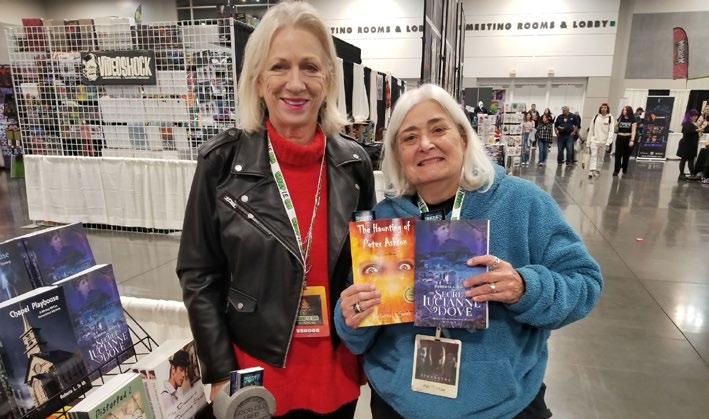
18 PULSE PUBLICATIONS May 2024
A Journey

AS
LIFE—OR
By J.P.Garner
of Love
FATE—WOULD HAVE IT, getting laid off from work was a door opening to something better for Linda Hodges and her husband, Robert. Looking back, she can see where not knowing what to do with herself led to her and Robert, becoming foster parents. The situations she saw were sad and, as she described her motivation, “. . . kept pulling at my heart.”
So much so that when they went to a pistachio festival in Newberry Springs, they visited a booth set up by A Greater Hope Foster Care Agency and applied. Linda’s niece, who was a recruiter of foster families for the organization, aided them in receiving their first assignment of two brothers who had been raised by a military family.
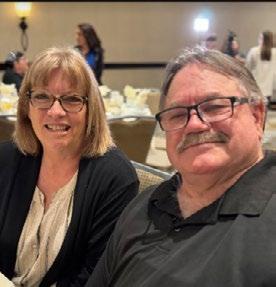
The youngest was four and the oldest, nine, and “. . . they were no problem,” Linda said. Robert added that “. . . at sundown, they’d go to bed,” and in the mornings they made their beds without being asked. It was automatic. “They stayed with us for six months,” Linda explained, “until their grandparents came from Florida and took them back.”
But five years and 20 kids later, and ready to retire, they started thinking about adopting. The concern was their age. “We weren’t sure if we were ready to take on little ones again. Then we met Paulino.”
There had been a lot of trauma in his life, so, in the beginning, there were punching walls, hiding under beds, and times he wouldn’t speak. It took a week for him to accept the Hodges. They refused to give up. “He had gotten our hearts,” said Linda. That was when he was four. Now that he’s nine and has grown up in a loving environment, “. . . he’s become a perfect little boy. He’s so good. A typical nine-year-old,” she continued.
Robert added, “He’s taking music lessons. He wants to play the electric guitar . . . like Jimi Hendrix. So, we bought him a small guitar and promised that if he learned to play that, we’d buy him a bigger guitar. And he’s an artist too.”
The sense of purpose and the love they felt for Paulino and received from him inspired them to take in Luvli, who was a two-month-old drug baby and had gone to another foster family for a short while before coming to the Hodges. Her mother was around but, according to Linda, “. . . kind of disappeared. But due to Zooming during COVID, there was no bonding going on between Luvli and her parents when they visited.”
They were asked if they wanted to adopt Luvli and they did without any hesitation. She was two when they became her parents. She’s four now and “. . . just the sweetest thing,” said Linda. When Luvli came into their lives permanently, they stopped fostering. Linda now helps people at her church who foster kids and, to her surprise, it “. . . feels like a calling.”
Someone nominated them for an award for their work as foster parents and here recently they were honored by the San Bernardino County Child Abuse Prevention program because they had protected the kids they fostered. “People have commented that these children are so blessed [because of us] but it is us who are blessed.
“They have made us better people.”
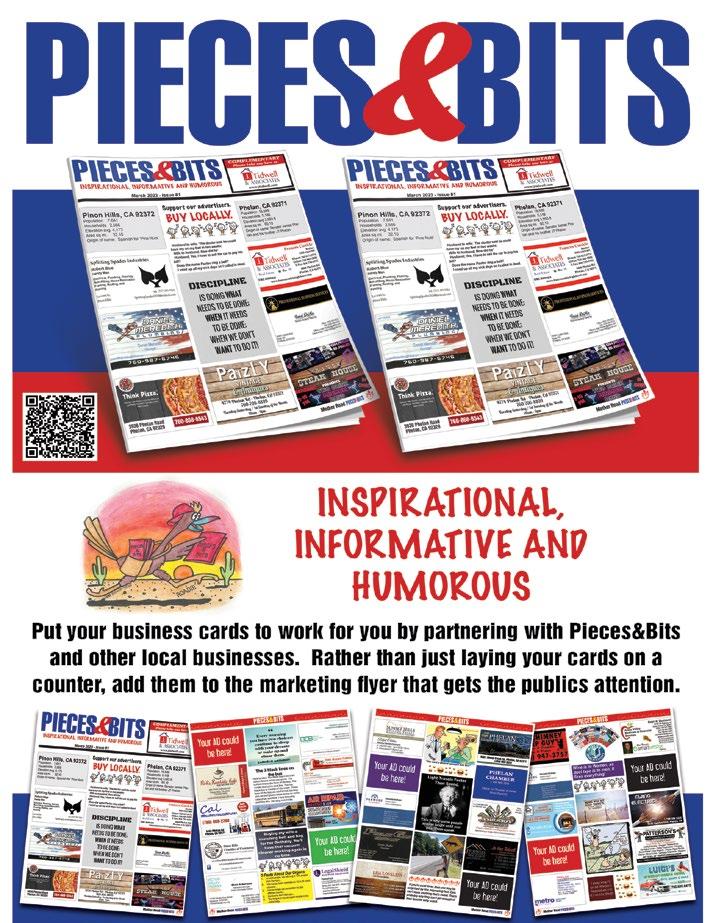

19 PULSE PUBLICATIONS May 2024
What Does Medicare Cover? Find Out Before the BillsArrive
By DailyCaring Editorial Team
BECAUSE MEDICARE is so complex, seniors can end up getting blindsided by huge medical or prescription medication costs when the bills arrive.
That’s why it’s important to figure out what Medicare will cover, what counts toward the deductible, what the co-pay will be, and how much will be paid out of pocket.
Estimating costs ahead of time means everyone will be better prepared when the bills arrive.
What Medicare covers is also important to know when it’s time to choose your older adult’s healthcare and prescription drug plans for the next year.
Being able to estimate costs ahead of time steers you toward plans that maximize coverage and minimize expenses.
We explain how to find out if something will be covered by Medicare, how to estimate costs for complex services, and where to get help understanding Medicare benefits.
What does Medicare cover? 3 steps to find out
In general, diagnostic tests (like x-rays or CT scans), preventive care check-ups, most surgeries, and hospital stays are covered.
Things like long term care, dental, and hearing aids aren’t covered.
3 steps to find out if something is covered:
Ask the doctor or medical facility if they accept your older adult’s specific Medicare plan for whatever is getting done – office visit, test, item, procedure, etc.

Go to this page on the Medicare.gov website, then scroll down to enter the test or service and click “Go” to search for it.
Check the search results to find out that item is covered and how much the patient will have to pay.
If the search doesn’t show the item you’re looking for, Medicare also provides an alphabetical list of various services and medical equipment. Click through an item to check the coverage.
How to estimate costs for complex services
If your older adult needs something more complex like surgery, look it up and also review the additional instructions for estimating those costs.
Generally, costs will be based on:
1. How much the doctor(s) and/or hospital will charge
2. If your older adult has other insurance plans
3. How much of their deductible remains

Get additional information about Medicare coverage
The Medicare website also has helpful information about the different Parts of Medicare, preventive services, what to do in a disaster or emergency, and more. Get more info about how these programs work and where to find your state’s SHIP.
Attend one of their Medicare Academy meetings or contact HDMedicare 760.205.3834 or visit their website HDMedicare.com


20 PULSE PUBLICATIONS May 2024


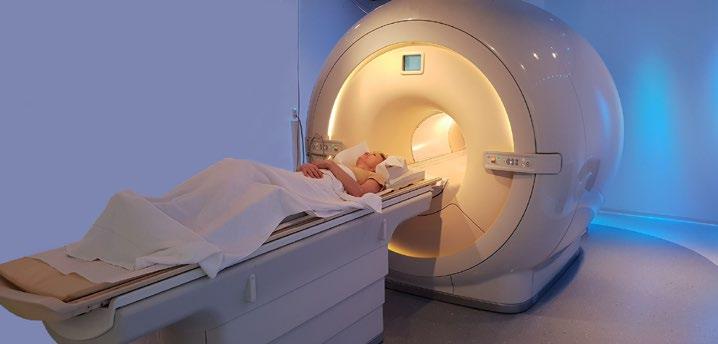

21 PULSE PUBLICATIONS May 2024 YOUR TRUSTED YOUR TRUSTED RADIOLOGY PARTNER RADIOLOGY PARTNER AT 14 CONVENIENT AT 14 CONVENIENT LOCATIONS IN THE LOCATIONS IN THE HIGH DESERT HIGH DESERT Breast Imaging & Intervention Minimally-Invasive Procedures Diagnostic Imaging Services 12490 Business Center DR, STE 200, Victorville, CA 92395 SOL MEDICAL IMAGING & BREAST CENTER 760-728-1900 Make An Appointment www.solradiology.com Visit our website: Affiliated Locations: SOL MEDICAL IMAGING CENTER | SUNVIEW 13010 Hesperia RD, STE 600, Victorville, CA 92395 Barstow Community Hospital Mountains Community Hospital Physicians Surgery Center Shasta Community Health Center Ridgecrest Regional Hospital Gateway Regional Medical Center Desert Valley Medical Group Victor Valley Global Medical Center Mad River Community Hospital Desert Valley Hospital Meridian Urgent Care & Occupational Health Bear Valley Community Hospital
Marcy’s Musings
Granite High School Students Explore Bell Mountain
AS A FOLLOW-UP TO THE THREE presentations given at Granite Hills High School on February 23, highlighting the two local ranches listed in the Green Book Travelers’ Guide, a group of 6 student members of the BSU, as well as 3 faculty advisors, ventured out to see some important sites in the Bell Mountain community. The March 29 fieldtrip was especially meaningful, as the area we explored is within the school’s boundaries, and some descendants of the original 26 Black homesteading families still reside there.
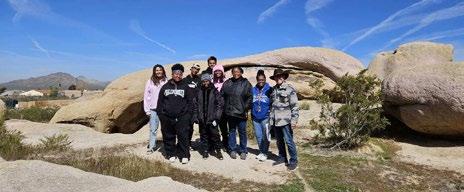
We assembled at the corner of Waalew and Dale Evans Parkway (formerly known as Bell Mountain Road) right across the street from the SE corner of the Murray’s Overall Wearing Dude Ranch, which operated from 1922 until the mid-1960’s. After an introduction describing what we could expect to see, supplemented by
color photos of the area, we set off to make a loop around the ranch perimeter.
From our second stop on Papago Trail, we walked to the site of the Murray’s main house, marked by a foundation and a few artifacts. From there we could see the home of second ranch owners, Pearl Bailey and Louis Belson, still standing just across the road. Also visible are the row of cypress trees Pearl herself planted for a windbreak over 70 years ago. From our stopping place, we could look straight down Popago Trail to Sycamore Rocks, where the two Herb Jeffries movies, “Harlem Rides the Range” and “The Bronze Buckaroo,” were filmed in the late 1930’s.
Stop number 3 was the triplex on Stoddard Wells Road, that was once the center of the Bell Mountain community, housing the Post Office, the Real Estate Office, and a small market and gas station. It is now a private residence.
Our fourth stop was the Lily Raglan Guest Ranch on Harris Lane, where many structures and remnants of ranch life are still visible. Coincidentally, a student in attendance, who lives in the adjoining property owned by her grandfather, said he was familiar with some of the history of the area. Sounds like an interview
A T-Shirt for Every Occasion
Tcandidate for sure!
The final field trip destination was the Sycamore Rocks property owned by John Blanc, a retired Apple Valley Unified School District teacher and counselor, as well as an MHS member. He led the group on a hike to the location of several scenes recognizable in the two movies: the cave, the unusual horizontally split rock ( a perfect photo op), and the rocky trail behind the huge rock formation, that had been blasted out so the horses could get through during filming.
The perfect weather and enthusiastic participants made for an enjoyable and educational experience, as the past was brought to life through stories, photos, and on-site locations. A big shout-out to the GHHS teachers, Mrs. Mosley, Ms. Speight, and Mrs. Holloway, for organizing this trip, and to the Blanc family for once again allowing me to bring a group onto your beautiful historic property.

HE MEMBERS and guests in attendance at the March Mohahve Historical Society meeting were “along for the ride” as VP Delvin Harbour took us on an adventure “Cruising Route 66 in Style.” Starting at the top of the pass at the Outpost Cafe, and continuing all the way across California to Needles, Delvin held up t-shirt after t-shirt marking interesting sites along the way. Of course, his first focus was on Old Town Victorville, as he’s worked for 12 years as a friendly
docent at the Route 66 Museum on D Street, where (you guessed it) they sell a variety of Route 66 t-shirts.
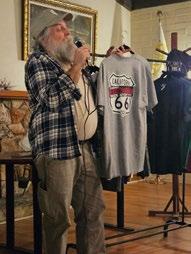
Traveling northeast along National Trails Highway, we experienced stops at Emma Jean’s Hollandburger Cafe in Victorville, the Bagdad Cafe in Newberry Springs, and the Wagon Wheel Restaurant in Needles. But we weren’t finished yet. Delvin had at least one t-shirt from each of the other seven states along the Route 66: Arizona, New Mexico, Texas, Oklahoma, Kansas, Missouri, and Illinois. Yes, even Kansas, with its 14 miles of Route 66 cutting across the southeast corner, was recognized with a t-shirt.
As a finale, Delvin shared his Route 66
hat collection, which led to a photo op with all in attendance sporting a Route 66 hat. Delvin, thank you for a great follow-up to our adventure the previous weekend. What an interesting way to take us through the eight states, and we didn’t even have to get out of our chairs. So everyone, take Delvin’s advice: Get out and explore! You’ll be glad you did.
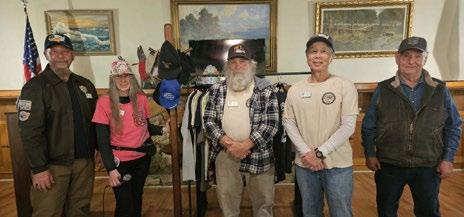
22 PULSE PUBLICATIONS May 2024
Mltaylor@gmx.com 1 760 985 1918
The Flying Aces VIP Tour Part 2- Poncho Barnes
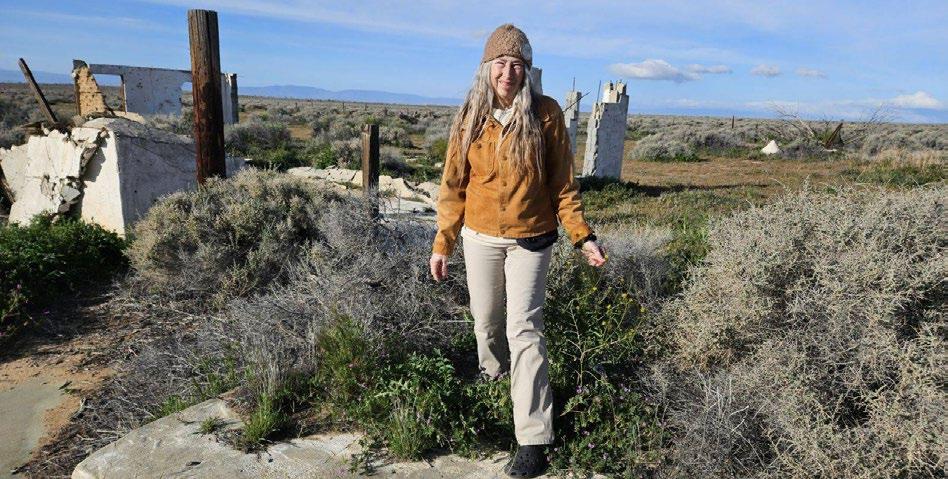
INEVER THOUGHT I’d ever get to see the Poncho Barnes Happy Bottom Riding Club. My first introduction to Poncho Barnes was when the MHS was still meeting at the Victor Valley Museum, and then Director Mary Hughes booked a performance by an actor and actress who portrayed Thaddeus Sobieski Constantine Lowe and his wife Leontine. Thaddeus Lowe, Civil War hero, aviator, and ballonist, was the grandfather who introduced his granddaughter, known as Poncho, to aviation and thus her love of flying. I really didn’t understand the importance of the relationship at the time. My next experience was when we were meeting at the Redeemer Church, and then MHS President Jim Mustra showed us the 1988 movie “The Legend of Poncho Barnes.” I learned that Poncho was a pioneering female pilot, of the era of Amelia Earhart, and had an unusual ranch near Edwards Air Force Base, known as the Happy Bottom Riding Club, where she entertained pilots and other guests, including Jimmy Doolittle and Chuck Yeager.

In September 2020, during the COVID era, we started doing outdoor fieldtrips to keep the organization alive. Our first adventure was to the property of MHS Life member Waldo Stakes, and his Museum of Speed in eastern Apple Valley. His large container displays include Air Speed, Land Speed, and Water Speed. In the back of the Air Speed exhibit was a Poncho Barnes Happy Bottom Ricing Club display, all ready to welcome Air Force pilots. It includes Poncho’s red velvet couch, a coffee table with a tray full of drinks, and other memorabilia. After that excursion I purchased 2 copies of the Poncho Barnes book, one for me and one for Waldo, and read it cover to cover. Fascinating!
Two years ago MHS members made a trip to Boron with several stops, first the 20 Mule Team Museum, and next the Air Museum that included a Poncho Barnes display area. An unexpected highlight was when one of the friendly docents took us a few blocks farther west to the little shack where Poncho’s life ended, much in contrast to the mansion she grew up in. She was a true “Riches to Rags” story, if ever I’ve heard one!
Sometime last year travel writer John Beyer published a two-part series in the “Daily Press” Sunday paper about Poncho Barnes and her adventures. He had landed a spot on a VIP tour of Edwards, which included a trip to the prior location of the Happy Bottom Riding Club, now within the Edwards Air Force Base restricted area, which inspired Part 1. Wow! Now I really wanted to go.
Fast forward to one of our current projects referenced in last month’s “Muse” and “Pulse” papers, concerning our desire to move the Yeager monument and statue outside the gate of Edwards
to the location of the soon-to-be-built new museum. Communications with the Friends of the Museum led to VP Delvin and I securing 2 seats on a VIP tour of Edwards at the invitation of Board member Rex Moen. Two other MHS members, Meera Maheswaren and Indran Subramanian, happened to be on that bus with a group from Military Officers Association of America (MOAA). Soon after check-in and a bumpy bus ride, we found ourselves right there, walking among the ruins of the Happy Bottom Riding Club, which had been put on the Register of Historic places in 1980. In fact, there were tributes to Poncho all over the base, in the museum, at her namesake cafe, and in the giftshop, where you could even purchase Happy Bottom men’s briefs among other items.
Poncho was quite a woman, despite looking and acting more like a man. She was a beloved homely female in a man’s world of aviation, with a mouth “like drunken sailor,” whose life was full of adventure. Despite her unhappy ending, in her glory days she provided much needed relaxation and entertainment to the pilots of nearby Muroc, later Edwards AFB. She made sure they had a good time before heading out on their next flight, always thinking it might be their last.
When the Mohahve Historical Society members venture back out to Edwards on our August fieldtrip, we will experience, among other things, the legacy that this early female pilot left on both the Air Force and the world of modern aviation.
Don’t miss this trip.
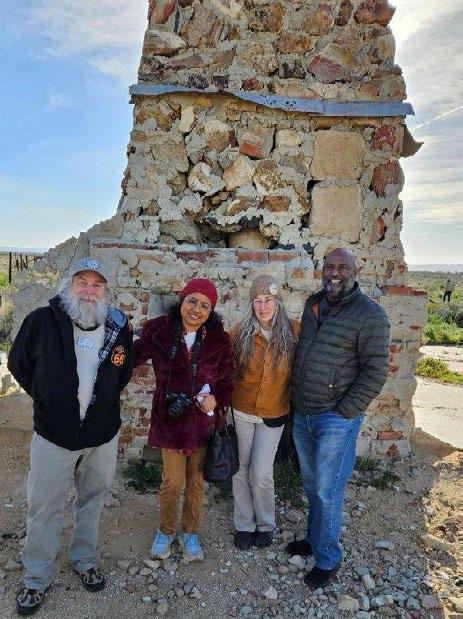
23 PULSE PUBLICATIONS May 2024 Mltaylor@gmx.com | 1 760 985 1918
Welcoming Home the Late 1800s Era Stagecoach
WHEN THE APPLE VALLEY
INN officially closed as a resort hotel, the iconic Apple Valley Inn stagecoach, purchased by Newton Bass in 1952 from a movie company filming in the area, had to find a new home. It was offered to the Victor Valley Museum, with which many Mohahve Historical Society members were involved, and which was at that time still operated locally. Roy Tate, Victor Valley Museum’s curator, accepted the stagecoach as a donation in 1991 from New Medico Valley Hospital Association, which was turning the Inn into a Brain Trauma Center. The acceptance tag reads: 1991.009.001. The stagecoach was for many years on display in the back part of the museum, along with some Roy Rogers and Dale Evans Western costumes and memorabilia, still on display in a different part of the museum today.
In 2010 the County of San Bernardino took over the museum. It was closed for over a year while some big changes were made. At the Grand Reopening event, we locals were a bit surprised, wondering what had happened to many of our previously displayed items, including the farm machinery and implements, the spinning wheel, artifacts of the pioneering era, and the George Air Force Base displays, among others. And where was the stagecoach?? Some items apparently found new homes in warehouses and storage rooms. Others that the County curators chose not to keep were picked up by the original owners or lenders.
On February 5, 2024, Jennifer Dickerson, Curator of History with the County of San Bernardino Museum, reached out to me to see if I would be interested in accepting the stagecoach in the name of the Apple Valley Legacy Museum, since we are located in Cottage 153 on the grounds of the Apple Valley Inn, where the stagecoach spent many happy years. My answer: “Yes, yes, yes!” On February 21,


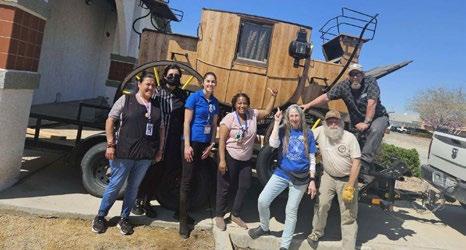
2024 the transfer agreement was signed by Museum Director David Myers...a big step forward.
Vice President Delvin and I were anxious to make a trip to the Victor Valley Museum, right on Apple Valley Road, where the stagecoach had apparently been hiding all of these years. We wanted to take some measurements and see what would be necessary to transport it. However, we were not granted permission to preview. We were told that “there were some refurbishments done to the stagecoach prior to the Victor Valley Museum becoming part of the County Museum system.” The staff provided us with some photos and measurements, but we really did not know what we were getting into.
Three of us, Delvin, Eric, and I, arrived on March 21, the designated pickup day, with Eric’s truck and flatbed, that was thankfully equipped with two winches. It wasn’t an easy task to move a vintage stagecoach with one missing wheel and propped up by a dolly and an assortment of boards. But assisted by five strong female County employees and a lot of ingenuity and maneuvering, and after removing a large plant, awkwardly guiding the stagecoach down a narrow passageway and under the arches,
and finally up the ramp into the flatbed, with the wheels catching on every crack and crevice they could find, the vintage stagecoach was off to its new (old) home at the Apple Valley Inn.
Don’t get me wrong. Despite all of that effort, we are happy and excited to have received this iconic artifact. It has garnered a lot of attention and brings back memories for many. After a little paint and tender loving care, we are ready to welcome guests to come on over and take a look. Photos of the Newton Bass era, and later the Roy Rogers era, showcase the stagecoach in all its glory. And who knew that the little cowboy perched on the top of the stagecoach in one of the vintage photos was our own member Jack Betterley? I’ll tell you who knew...his wife Barbara. She said to me, “Let me look a little closer at that picture. I think that’s Jack!” Lo and behold! As one of the 60’s era brochures states: “Roy and Dale say Apple Valley is for Fun!” It still is. Thanks to Victor Valley Museum employees and MHS volunteers for your efforts in this endeavor to save a piece of history for locals and visitors to once again enjoy.

24 PULSE PUBLICATIONS May 2024 Mltaylor@gmx.com | 1 760 985 1918
Apple Valley Legacy Museum Celebrates 9 Years

THE APPLE VALLEY LEGACY
MUSEUM’S 9-Year Anniversary event the weekend of April 5, 6, and 7 had some interesting weather. Despite wind, rain, hail, and snow on Friday, interfering with the first day’s planned porch sale and silent auction, Saturday was thankfully the most beautiful weather imaginable for this time of year: warm, sunny, and NO WIND!
As they entered, attendees were treated to the music of the Dynamic Dulcimers and Bonnie on the Keys, and had a chance to visit the museum, shop for collectibles, buy raffle tickets, or place a silent auction bid. Other highlights were the chicken

dinner served by “Roy Rogers’ Reliable Relatives,” David and Ollie Odell, and photo ops with the original Apple Valley Inn stagecoach, back home at last.
Cameras and cellphones captured many other memorable scenes: the “Genuine Desert Animals” skit, line dancing, raffle
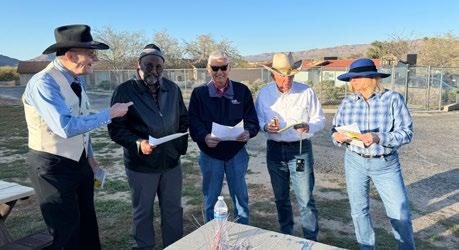
winners, and the traditional sing-along, with Roy’s nephew and others joining the High Desert Jammers for “Happy Trails.”
Many volunteers, along with talented musicians and singers, all working for the good of the cause, made this event possible. A big thank-you goes out to the AVLM team, Mohahve Historical Society and Military Officers Association of America members, other guests, and especially the volunteers who worked behind the scenes, for your interest in preserving and sharing local history.

Upcoming Community Events
May 2, 9, 16, 23, 30 - Apple Valley Concerts in the Courtyard- 6-8:00 Free admission
May 4- Apple Valley Flea Market 8-1:00 Lions Park- Bands, vendors, Free admission
May 13- NAACP Branch 1082 General Membership meeting 7:00 PM, all are welcome
May 11- Santa Fe Trading Company Crafts Fair 10-4:00 Old Town Victorville on 7th Street north of Forrest Bands, vendors, Mother’s Day gifts, free admission
May 14- Friends of the Apple Valley Library meeting 11:00, Presentation by the Cactus Wren Garden Club, all are welcome
May 17- Black Excellence Celebration at Victor Valley College 5-8 PM, ticketed event
May 23- Mohahve Historical Society monthly meeting, Lone Wolf Colony, doors open 6:30, speaker Scott Johnson “Mid-Century Modern Architecture” including the McDonald’s Arches
May 25- Mohahve Historical Society monthly fieldtrip- Pioneer Town- meet there at 10:00, members free, guests $10
Call (760) 985-1918 for further information about these events
25 PULSE PUBLICATIONS May 2024
Mltaylor@gmx.com | 1 760 985 1918
What’s in a Name? Cloud Gate
Although it’s most commonly called “The Bean,” in reference to its distinctive shape, the actual name of Chicago’s most famous sculpture is Cloud Gate. It was unveiled in Millenium Park in 2004 and has since become one of the city’s most popular attractions. Designed by British sculptor Anish Kapoor, Cloud Gate remains his most famous work to date. Although the piece is magnificent, the name is deceptively simple: Kapoor chose Cloud Gate for the clouds that can be seen in the sculpture’s reflective surface and for the way the curved underside serves as a gate to the park.
Play with it!
• Cloud Gate
• The Bean
• Chicago
• Sculpture
• AnishKapoor
• British Sculptor
• Reflective
• Attraction
• Gate
• 2004
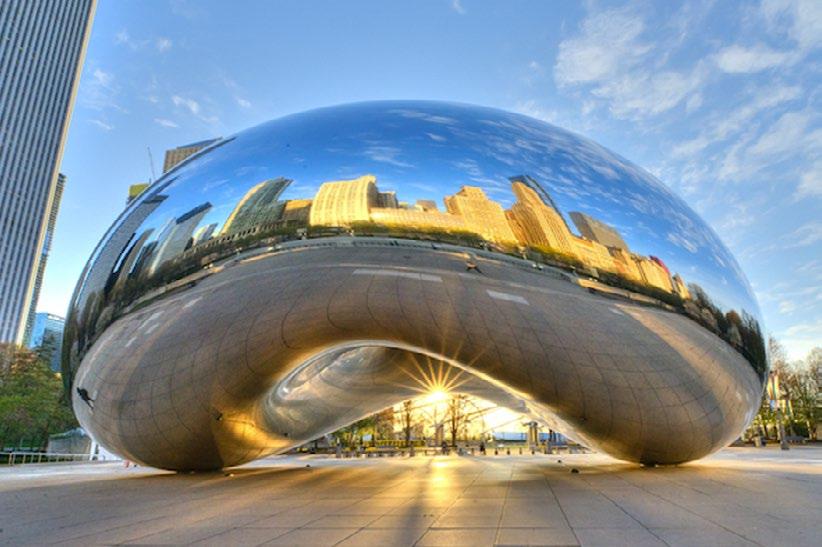
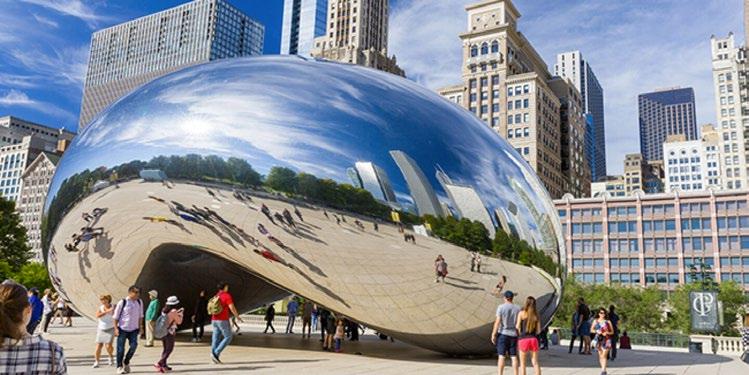
26 PULSE PUBLICATIONS May 2024
Answers in the June issue
Hunting Words
In the next issue, DEVILS TOWER Answers from the April issue Crossword Puzzle 1M 2R O O W 3 G 4H N N O R A W 5 B O 6R A L P H N A D E R D I N S 7H T 8P R E S I D E N T S A B O D E R H 9C A R O L 10I N E U G S L 11J A C K I E O O Down: Across: E T G V A T T R A C T U E G N X H N K 2 0 0 4 X B 7 R 0 2 A C E G H J K I U Y T U S A C N 3 B F C N M J G A T E 8 T F I S E R H L 5 6 Y P J K L T E S E A V I G O Y L 8 J K L R W H C N V C F G U R Y U I O A L K X C V A F C Y D I O P 0 C M A 4 5 T G S H J K G O I N T B P 4 R F O B N H J K A O P I 3 O C V B H G A T E Y H T K O O O 2 3 R E F L E C T I V E N I R B R I T I S H S C U L P T O R
Don’t miss out...events are fillin’ up!
Seniors With Inquiring Minds
Percy Bakker Community Center
9333 “E” Avenue
Hesperia, CA 92345
Thursday, May 2
Shery Sullivan - Health Care
Thursday, May 9 Open forum - Meet and Greet
Thursday, May 16
Mary Langer Thompson - Acrylic Pour & Healing through the arts
Thursday, May 23 Leah McEntee - history of left handers for 10% of all humans
Thursday, May 30 Open forum - Meet and Greet
Widows or Widowers of High Desert
Saturday at 9 am Questions call 702-526-6421
Trinity Lutheran Church, 16138 Molina Dr. Victorville
Saturday, May 4th. It’s the Kentucky (Hobby Horse) Derby
Saturday, May 11th. We will celebrate Mother’s Day.
Saturday, May 18th. Breakfast at Denny’s on Main St. in Hesperia at 10 am
Saturday, May 25th. Member Tom Reynolds will do a presentation on Music in the Movies

Friends of the Apple Valley Library
14901 Dale Evans Parkway
Apple Valley, CA 92307
Tuesday, May 14, 2024 from 11:00 AM - 1230 PM
Speaker: Lori Nielsen, President of The Cactus Wren Garden Club
Topic: Native plants and some tips for your garden.
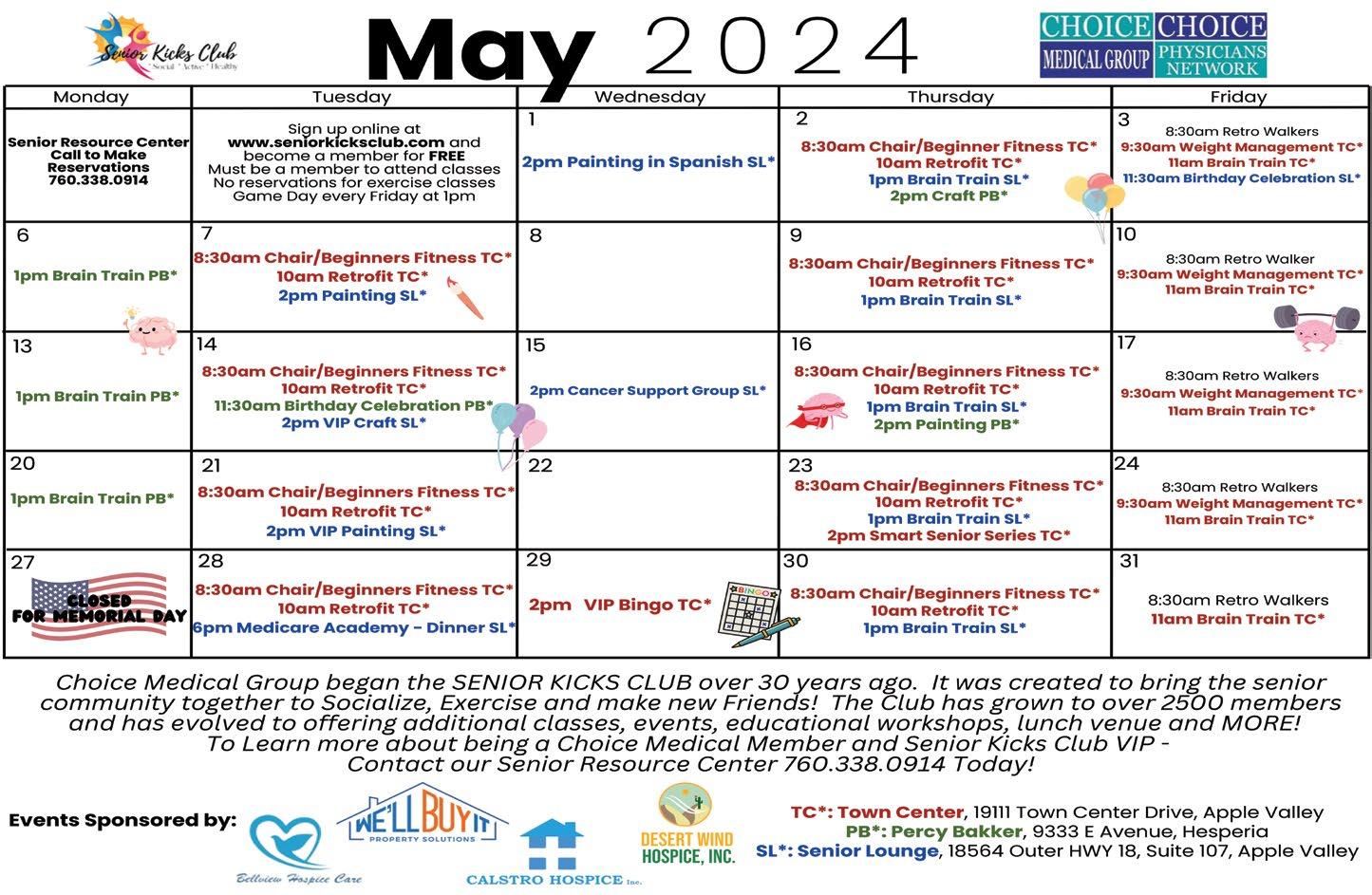
27 PULSE PUBLICATIONS May 2024
Holcomb Valley, a Golden Opportunity
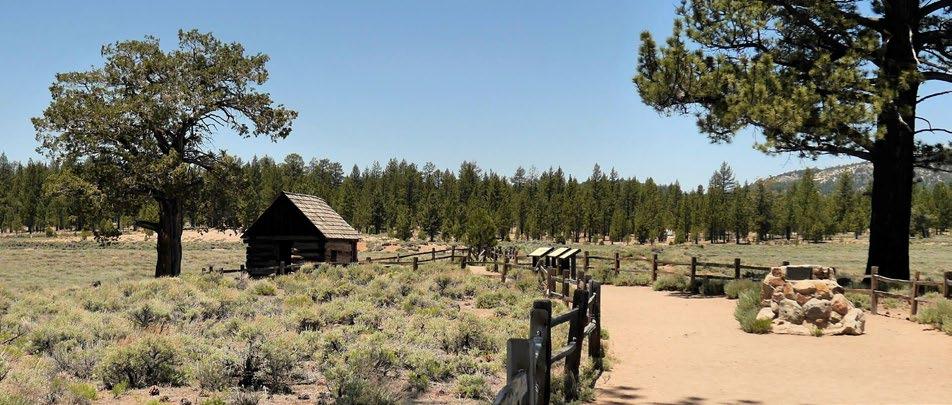
WHEN I WAS A YOUNG BOY, way back in the 20th century, my father took me gold panning in the San Bernardino Mountains early one spring. We spent countless hours on the streams and finally, after those countless hours, my father would inevitably announce, “It’s all been played out.”
I didn’t know what that meant, unless he was describing how I would get tuckered out after playing sports all day with my friends.
“He’s played out.”
My mother would nod her head. “He looks played out.”
Turns out, what he meant was there was no gold to be found where we had been panning. So we’d move on to a different stream after lunch or the next day.
That wasn’t the case in May of 1860, when gold was found in those same San Bernardino Mountains by William F. Holcomb and Ben Choteau. Hmmm, I wonder if there’s a connection to why the area was named Holcomb Valley later on? Could just as easily have named Choteau Valley. Perhaps Ben’s last name sounded like somewhere one would spend the weekend in the French winery in the country.
Thar’s gold in them hills!
Anyway, gold was found by these two gentlemen, and like any gold discovery, secrets were not very secret for long.
“You know, Holcomb found gold right beneath the surface up in the mountains,” a miner stated to another miner – I wasn’t there for this conversation, but go with me on this one, okay?
“What about Choteau?”
“I think he’s introducing a new vintage of Chardonnay soon.”
With the news of the gold, literally being dug out of the ground in the valley just north of present day Big Bear Lake, prospectors
flooded the area looking to realize their own dreams of riches.
It should be noted, that gold was considered a precious metal during those days, not like today. No one would desire a gold necklace, earrings or bracelet during these enlightened times in which we now live. That would be just a waste of sparkly minerals and be so personally shallow.
Laureen, are you reading this?
Within months, the area boasted a population of 1,500 people. That doesn’t sound like a lot of folks, but it was. Considering the hardship these pioneers had to endure just to reach the mountain top from the valleys far below, this was a great deal of people.
Seems there is a theme when I write many of these articles, the fortitude and strength these adventurers showed is truly awe inspiring.
To get to Holcomb Valley today, we simply drive up in our comfy vehicles, turn on to a dirt road and within a short span of time, are motoring around a beautiful serene
B y John R Beyer
mountain valley. Lush, with green grasses, willowy bushes, and tall proud pines.
This gold discovery occurred just a short decade after California had become a state. This new and very large piece of real estate was a titch over 2,600 miles from the capital of the United States in Washington D.C. This was really new land for exploring – all of these pioneers were a tough breed to venture so far from ‘civilized’ civilization on the East Coast.
But even prior to Holcomb and Choteau, this valley, as well as the Big Bear Valley – before it was known as such, was the part-time residence of the Serrano Native Americans. They would migrate to the mountains during the late spring and summer months to get out of the heat of the deserts or lands near modern day San Bernardino. Here they would hunt, gather food stuffs and fish in the mountain creeks. With the coming of the cold winter, they would travel off the mountain and back to the deserts and valleys below.
Then, around 1845 a posse of about twenty men, led by Benjamin Wilson – who would be the grandfather of General George S. Patton - rode into Big Bear Valley chasing a couple of outlaws, who had been raiding ranches in what would later become the city of Riverside. Not sure if they caught the desperados, but what they did find was the land crawling with Grizzly Bears – and that’s how Big Bear obtained its current name.
Yes, I wrote – Grizzly Bears, as in Grizzles!
The hunt for bear skins was on and, unfortunately, research indicates that around 1906 the last San Bernardino Mountain dwelling grizzly bear was killed.
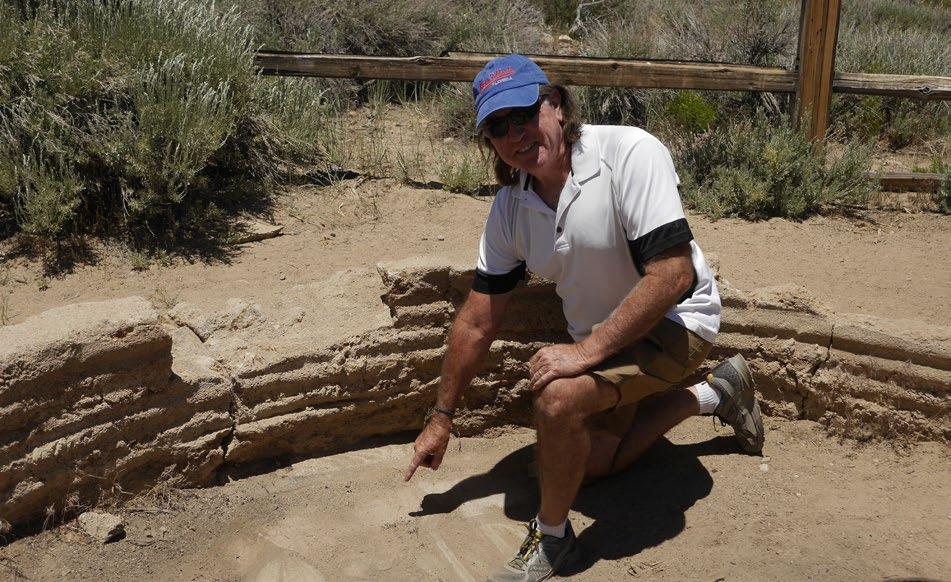
28 PULSE PUBLICATIONS May 2024
And in October of 1916, supposedly, the last grizzly bear was killed in California by a farmer by the name of Cornelius B. Johnson in Los Angeles County.
Strange that the grizzly bear was named California’s official State Animal in 1953, decades after humans wiped them out. Perhaps it was a way of saying: Hey, we’re sorry
But I digress: back to Holcomb Valley.
With that discovery of gold, and the secret out, the valley was soon swarming with miners, shop owners, gamblers, whiskey suppliers, and all kinds of other folks who saw there were other ways of making a fortune without getting their fingernails too dirty.
The town of Belleville was born in the booming Holcomb Valley. Literally, the name was delivered along with the birth of the first child in the valley, named Belle. The citizens thought, in honor of this brave little girl coming into such a rough and tumble world, they would name the town after her.
Belleville soon became the fourth largest town in Southern California, but with many of the unsavory characters who found their way up the mountain, it also became a rather desperate place to live. True frontier justice – that’d be vigilante justice, was the norm for the day to try to corral these bad hombres.
Hang in there Belle!
The gold kept coming and the miners kept digging. Soon, this area was producing the most gold and wealth of any other mining

area in Southern California.
But with all things golden, the time for Belleville started to decline and by 1870 most of the population had moved on, looking for other golden opportunities. Soon, nothing was left but a valley scarred by the remnants of past mining activities amidst few reminders that humans once resided here.
A drive through the valley is well worth the time. There is an interpretative guide that can be picked up at the Big Bear Discovery Center in Fawnskin, which will point out
some pretty interesting places in Holcomb Valley – a miner’s cabin, a slag pile from past gold diggings, an arrastre, and so many other sites to view.
So, get out of the heat of the desert and take a historical drive through Holcomb Valley. When Laureen and I went, it was twenty-one degrees cooler at the top than it was at our home in the High Desert. That alone is worth the drive, when the summer sizzles and the thermometer is reaching a hundred and seventy degrees.
Stay cool, my friends.
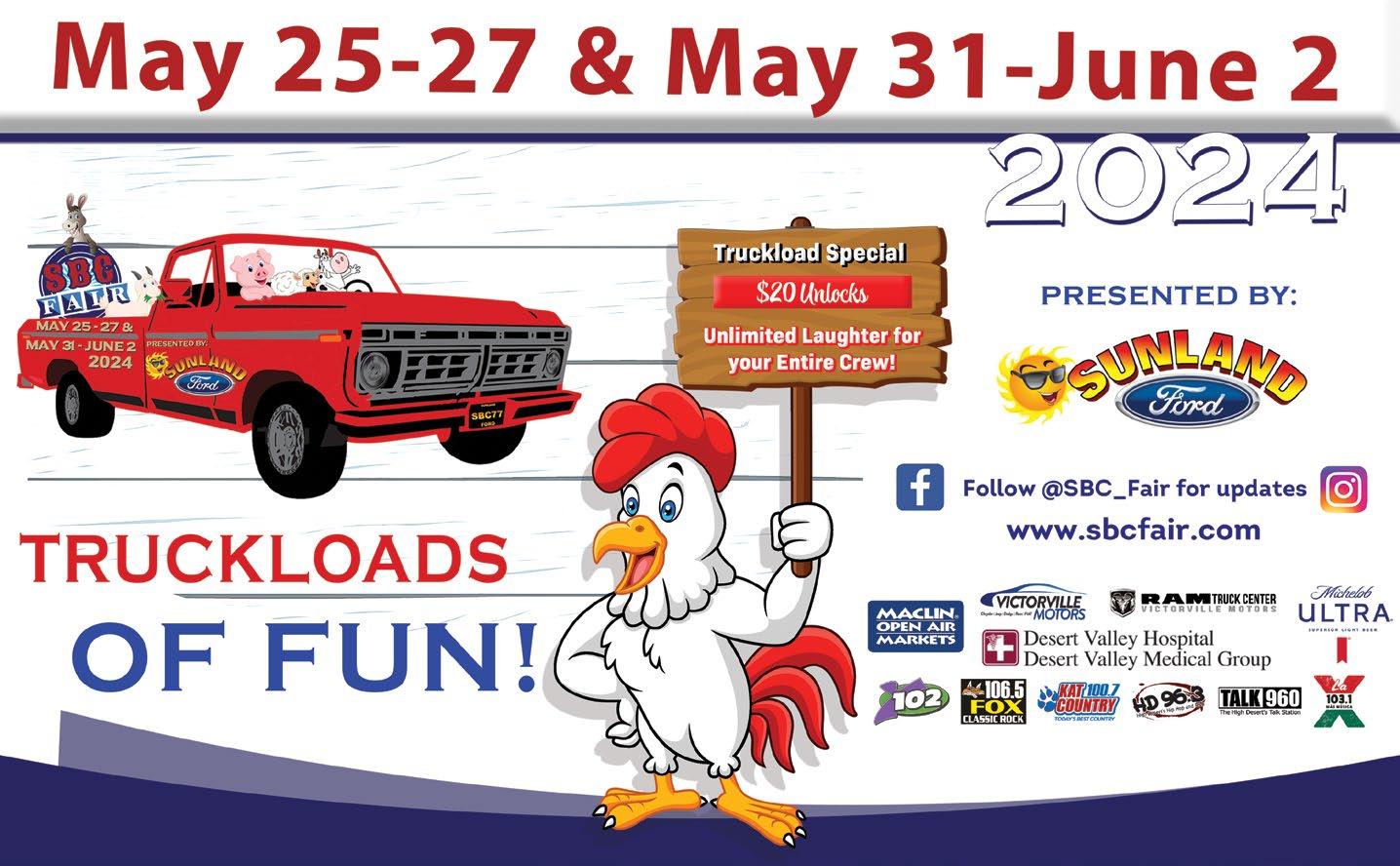
29 PULSE PUBLICATIONS May 2024
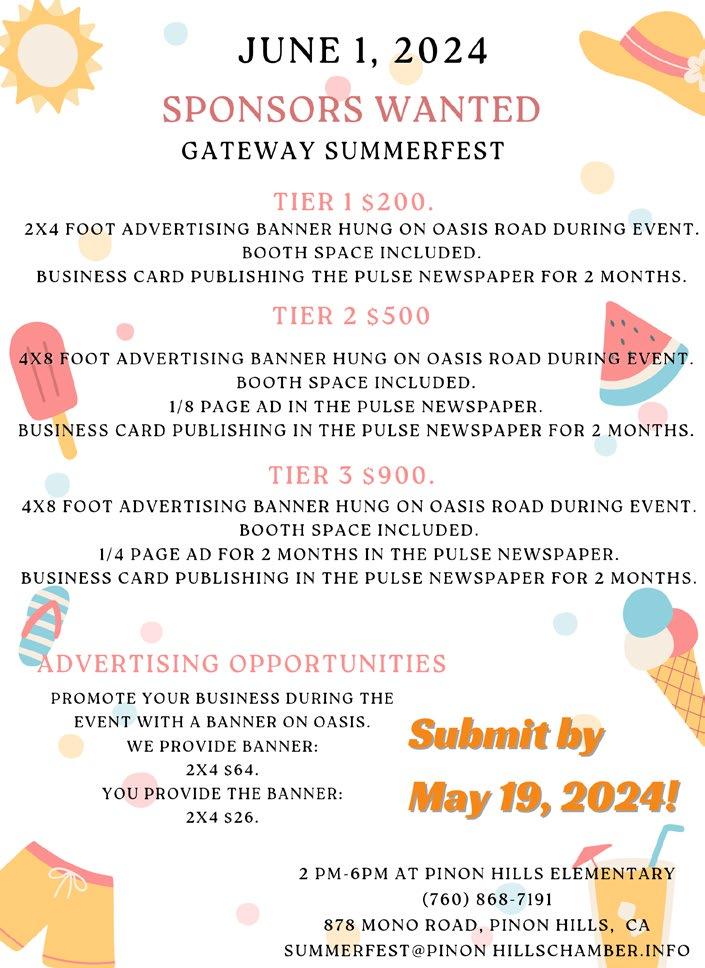
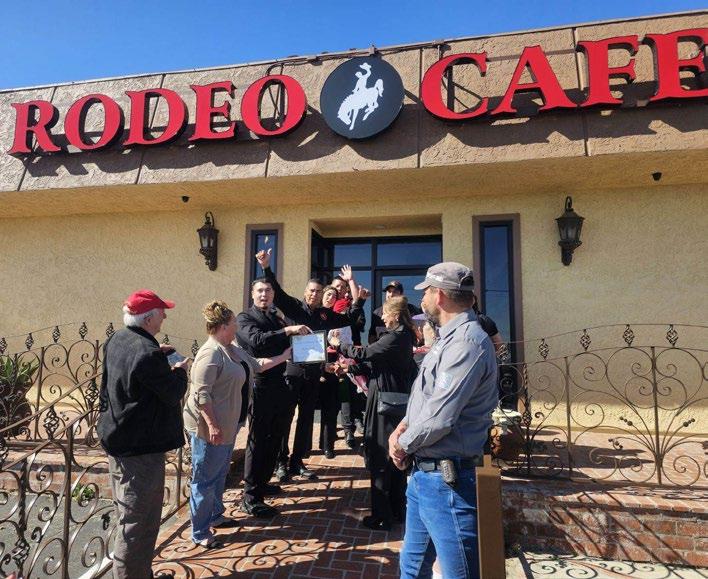
ON FRIDAY APRIL 19TH a Ribbon Cutting ceremony was held at the new Rodeo Cafe in Pinon Hills. This is their 5th location and first in the High Desert area. The event was hosted by the Pinon Hills Chamber. The owners, who are also the managers have turned this location into a very nice restaurant, or as they call it a Cafe.
The decor and menu are right out of the old west. The John Wayne is my favorite breakfast dish. They are open everyday for breakfast and lunch.
Mark your calendars for the 2024 Gateway Summerfest on June 1st!
This event is a celebration of local businesses and artists, providing a unique and invaluable opportunity for vendors to showcase their products and services, and contribute to the vibrant atmosphere of the event.
The Piñon Hills Chamber of Commerce has been orchestrating this annual gathering since 2007, taking a short break only during the years 2020 and 2021. This event is a testament to the community’s enduring legacy and cultural richness, set against the picturesque backdrop where the desert’s tranquility meets the mountains’ grandeur.
In the Golden State, small enterprises play a pivotal role in job creation and form a major segment of the employment landscape. Yet, alarmingly, almost 50% face the threat of shutting down. This elevates the role of consumer patronage from important to essential. Opting for local businesses over the allure of online convenience is more than a choice—it’s an investment in the economic vitality and employment stability of our communities.
The festival will include an artisan market, music, food vendors, a kid’s zone, raffles, and more. The outdoor event is scheduled from 2 to 6 p.m. on June 1st at Piñon Hills Elementary School, 878 Mono Road.
This free community event is open to all; Kids Zone wristbands provide unlimited entry to the various attractions. The Purchase of wristbands is $5.00 at the gate or at a reduced price of 5 for $20 before the doors open.
For more information, follow the event on Facebook or sign up at http://pinonhillsthegateway.com. Share the fun with friends and family and support your local small businesses!
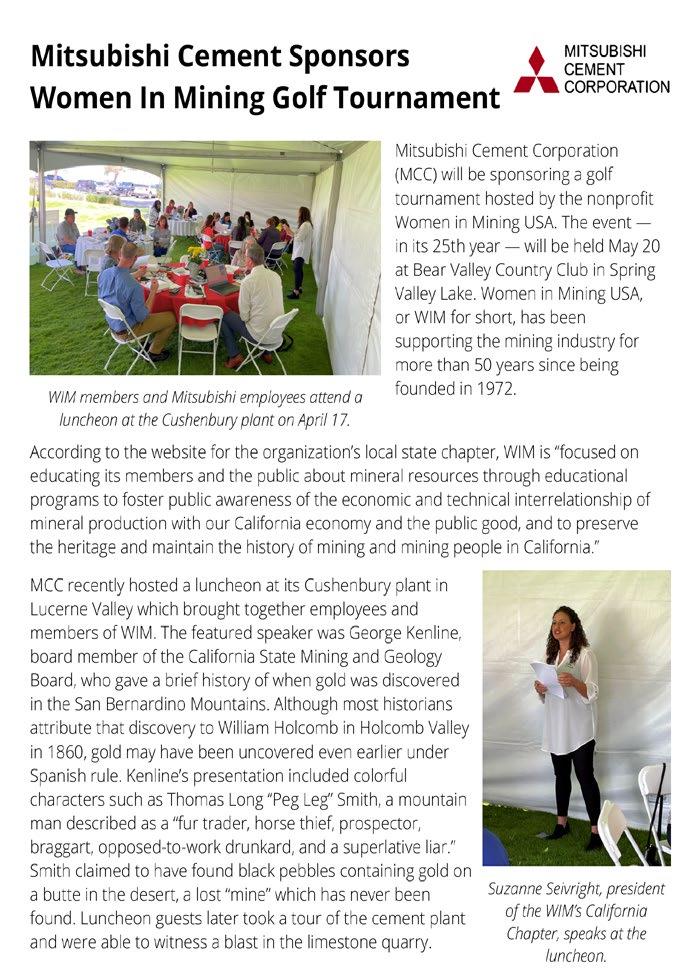
30 PULSE PUBLICATIONS May 2024


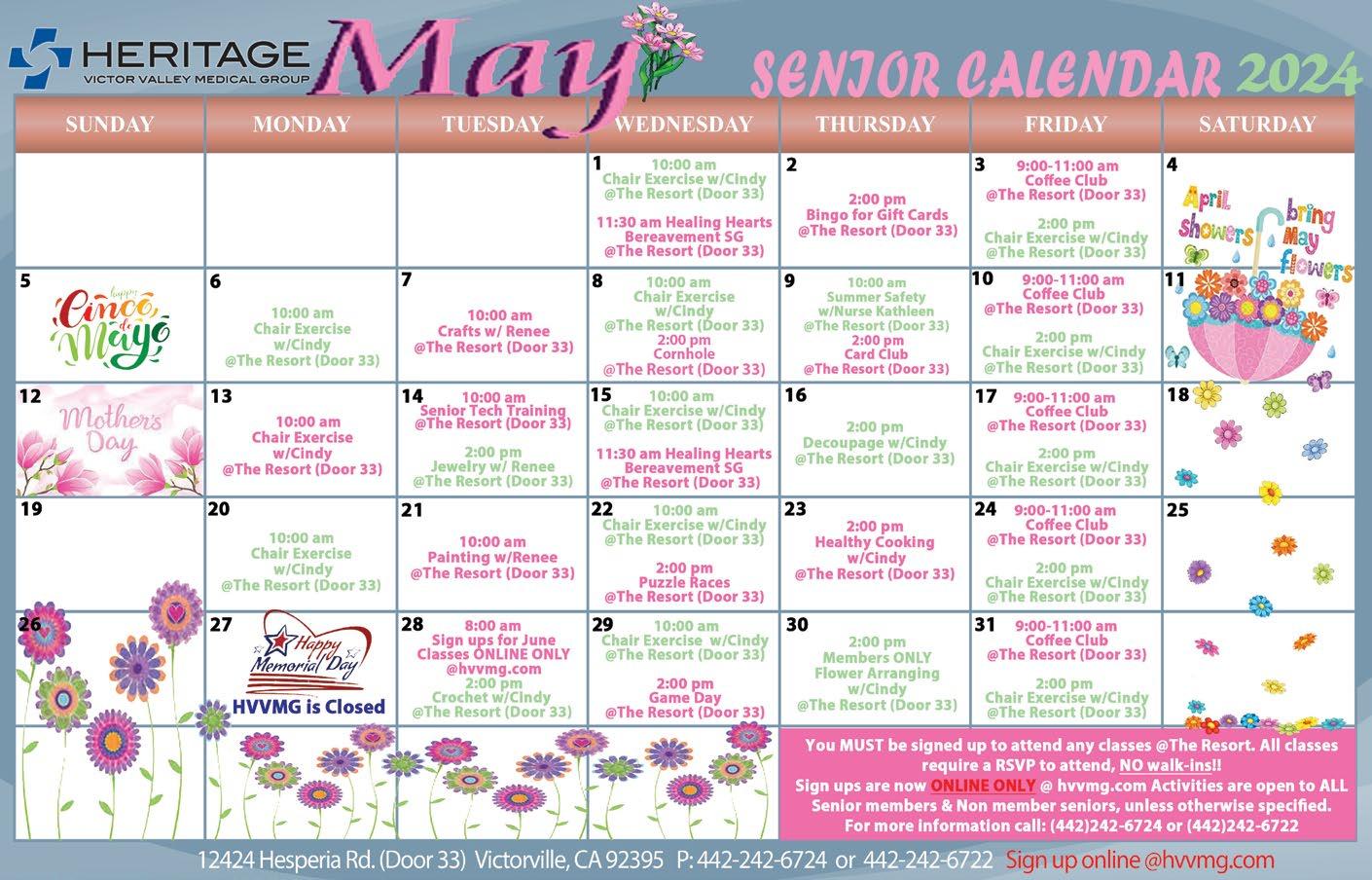
31 PULSE PUBLICATIONS May 2024 Medicare 101 Your guide to understanding Medicare Turning 65 or new to Medicare? Questions about the enrollment process? Join our Medicare 101 class! Sign up online at hvvmg.com/medicare or scan the code! In this class we will cover the four parts of Medicare and all your options. Gain confidence in your medicare choices in a relaxing environment with knowledgable specialists. Join us at 12370 Hesperia Road in Suite 13 in Victorville! MAY 13 10A JUN 10 10A JUN 27 5P MAY 23 5P

JOIN THE ACADEMY!
Celebrate your upcoming Birthday with a light dinner/cake! We will cover general Medicare information, Tips & Tricks & provide plan benefit information. Let us help you navigate through the confusion of Medicare and determine the BEST Medicare health plan for your healthcare needs. Meetings held on the Last Tuesday of the Month 5:30pm or call for other location dates/times. .

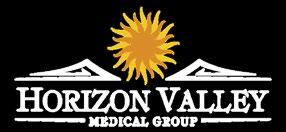
32 PULSE PUBLICATIONS May 2024
ELIMINATE THE CONFUSION!
New to Medicare or Turning 65 soon?
760.205.3834 HDMEDICARE.COM WeCare@ChoiceMG.com Facebook: HD Medicare Q&A Senior
Center/Lounge 18564 Hwy 18, Apple Valley
Resource


33 PULSE PUBLICATIONS May 2024 13th Year! The Right Choice... To Better Your Health!
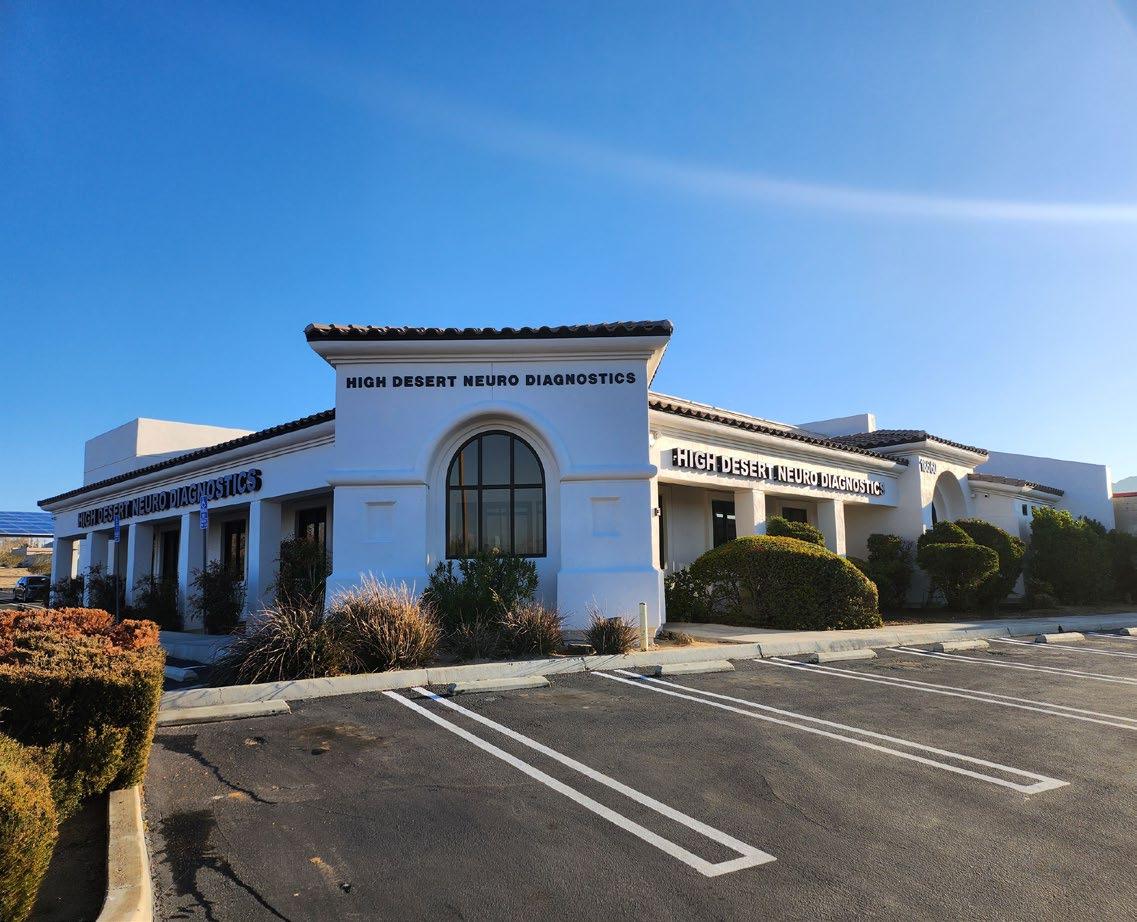
HIGH DESERT NEURO DIAGNOSTIC
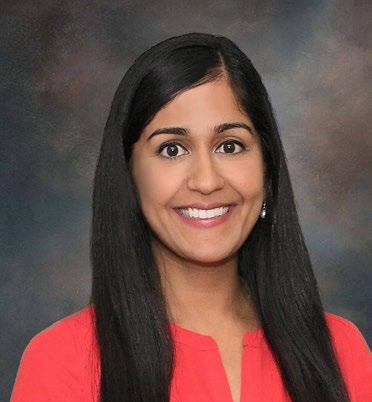


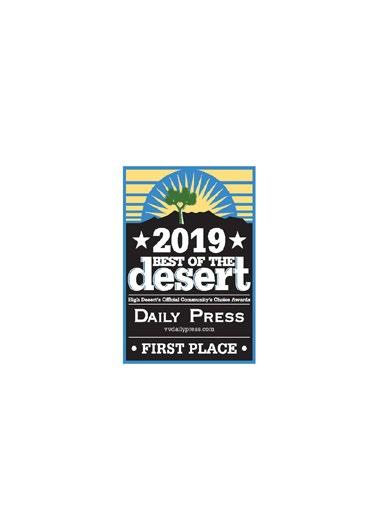


High Desert Neuro Diagnostic is widely known and respected for the expertise of their staff and the superb quality of their care.
They treat patients of all ages and are strongly committed to the care and compassion of their patients.

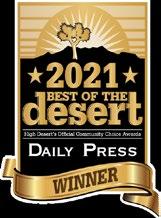



34 PULSE PUBLICATIONS May 2024 Facebook @highdesertneuro
1 8 6 6 0 O u t e r H i g h w a y 1 8 , A p p l e V a l l e y , C A 9 2 3 0 7 * 7 6 0 . 9 4 6 . 3 8 7 6 on Instagram @high desert neuro Visit our website HighDesertNeuro com
Sonia Nayyar, MD
Eduardo Gallegos, MD Neurology and Neuromuscular/EMG
Yuxiang Zhang, M.D Neurology Neurology and Neurophysiology








































































 By Jaylyn And John Earl www.thedesertway.com
By Jaylyn And John Earl www.thedesertway.com








































































